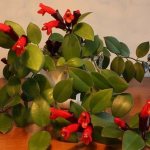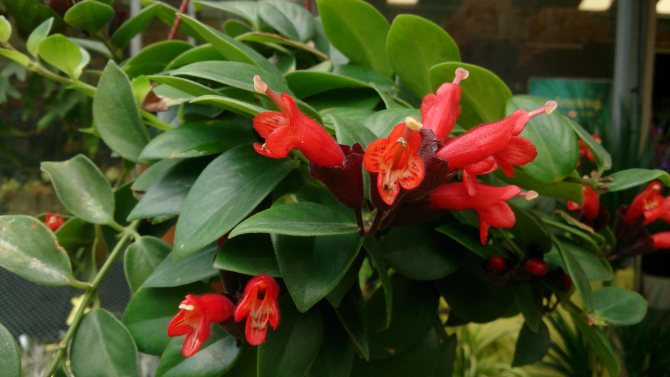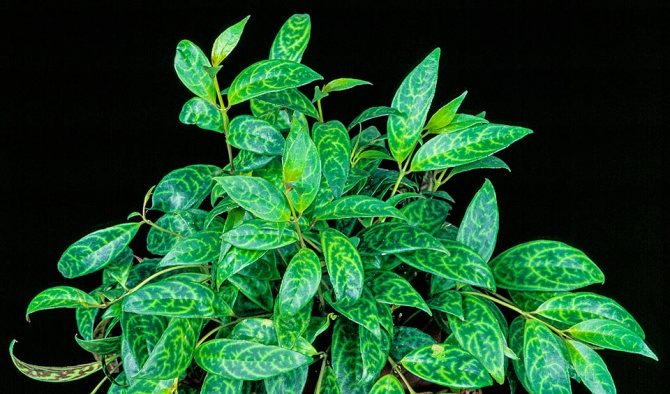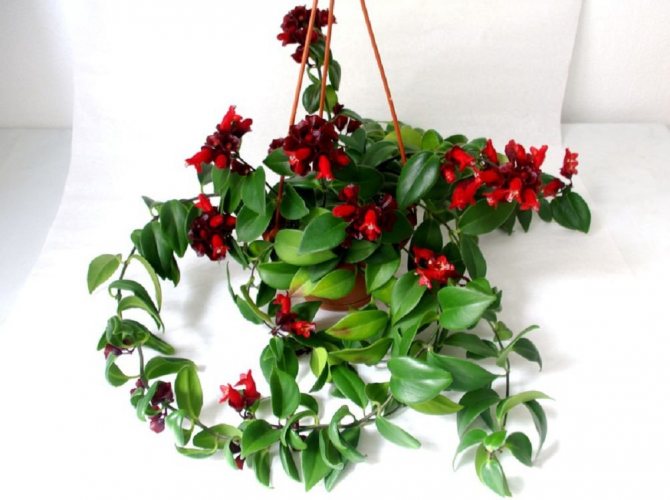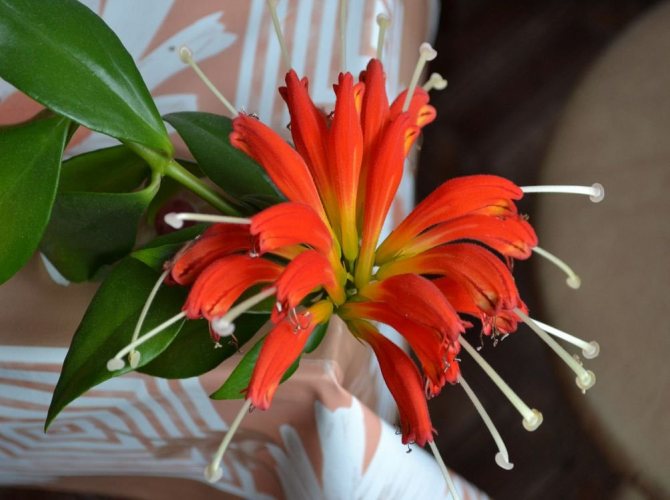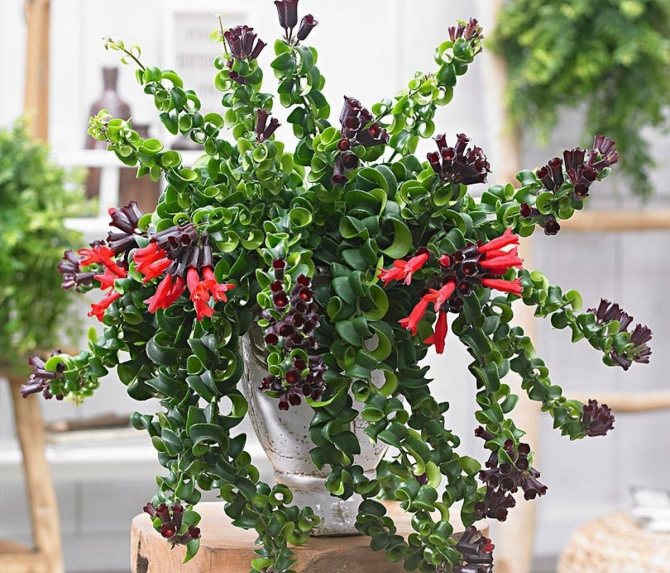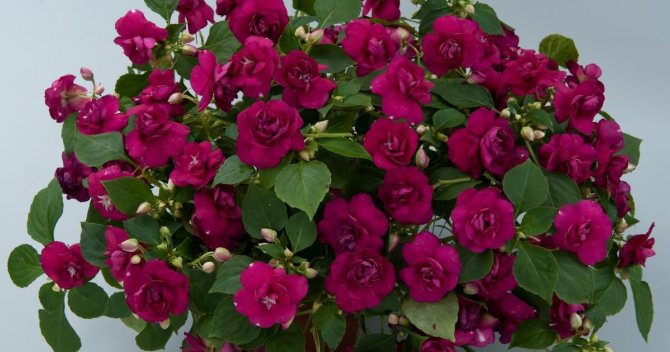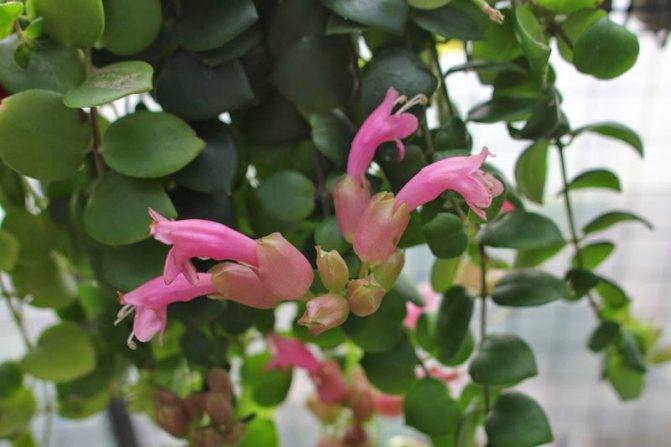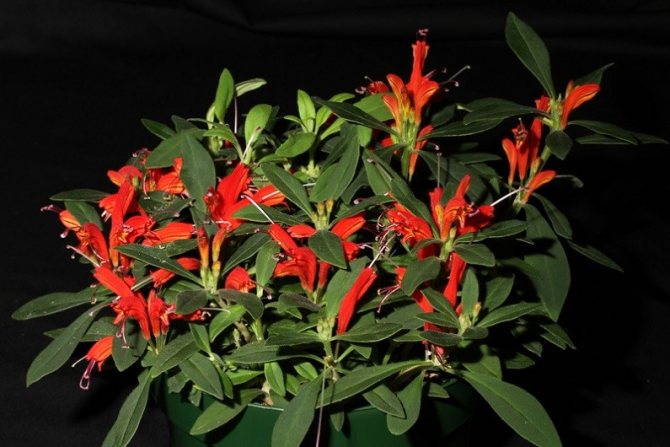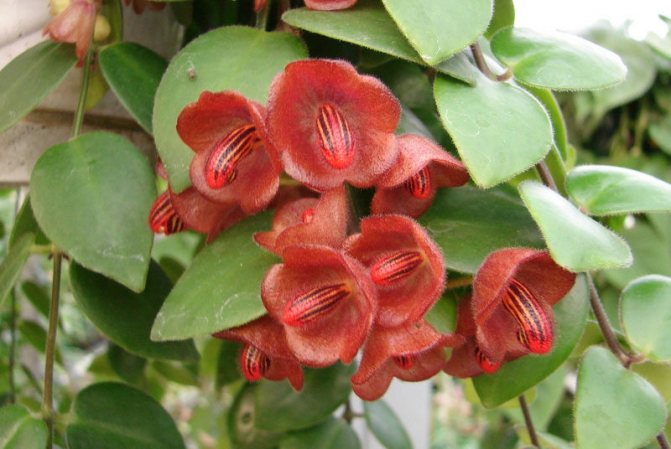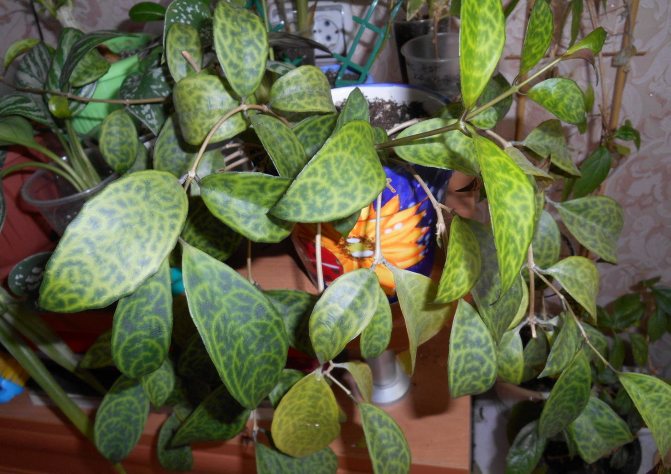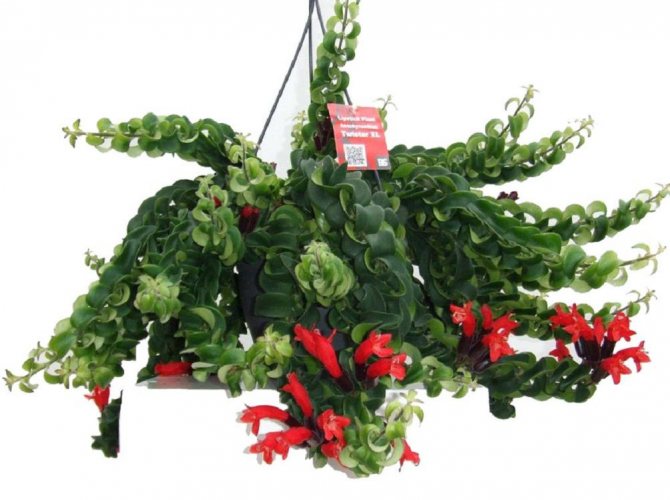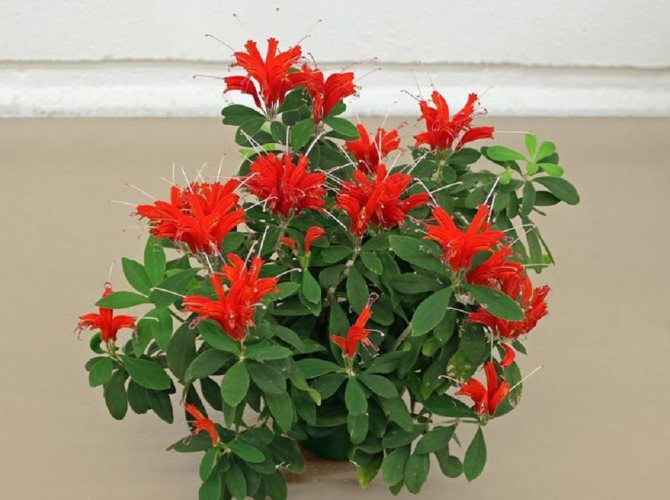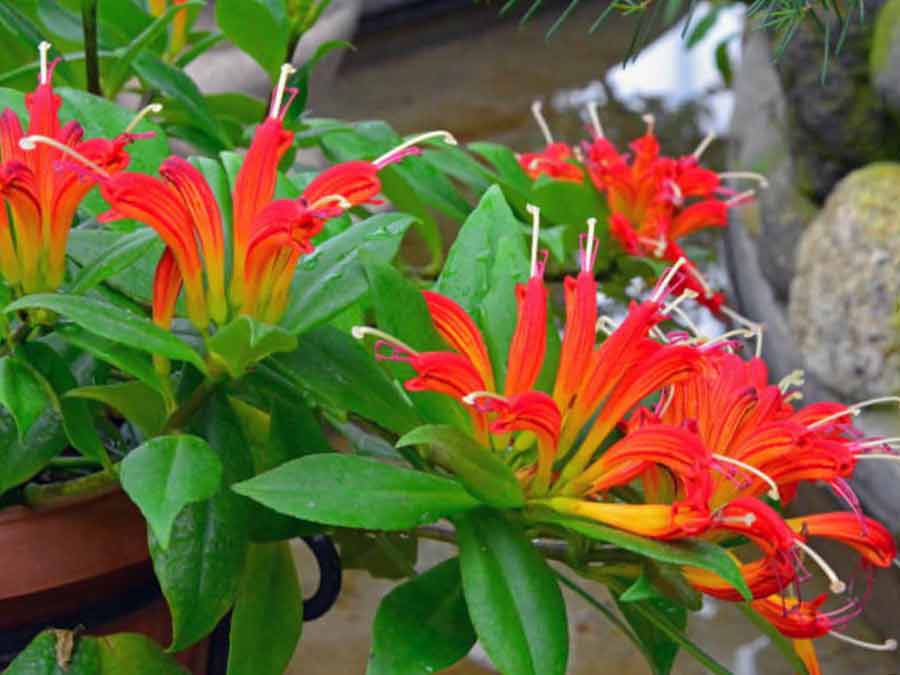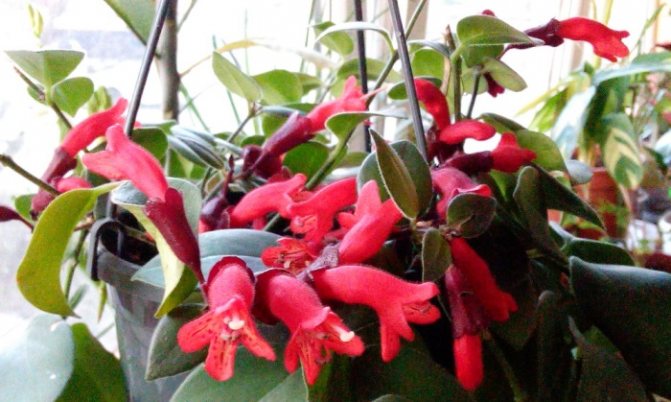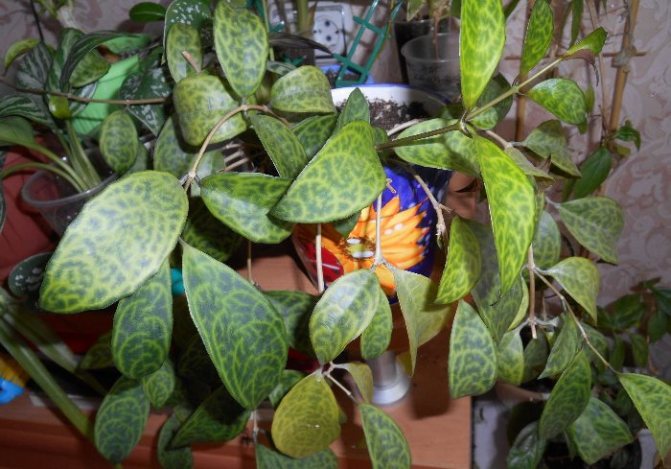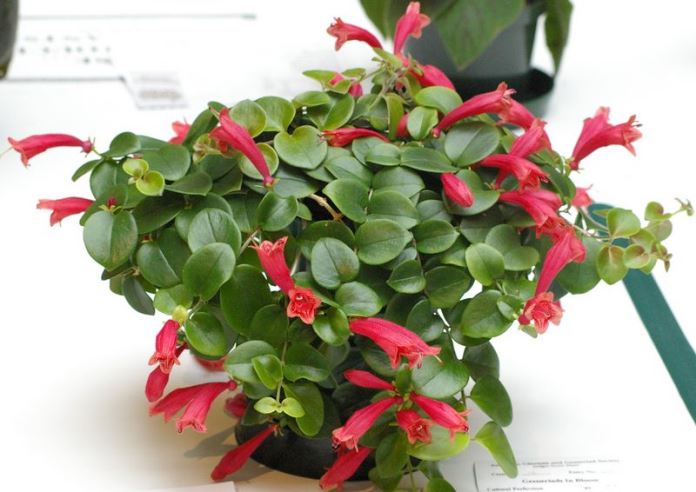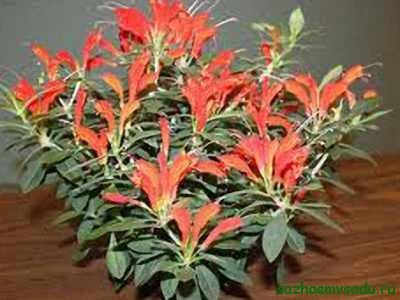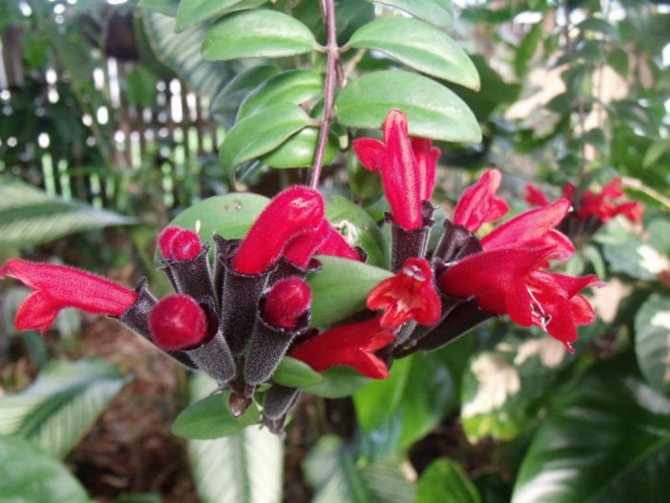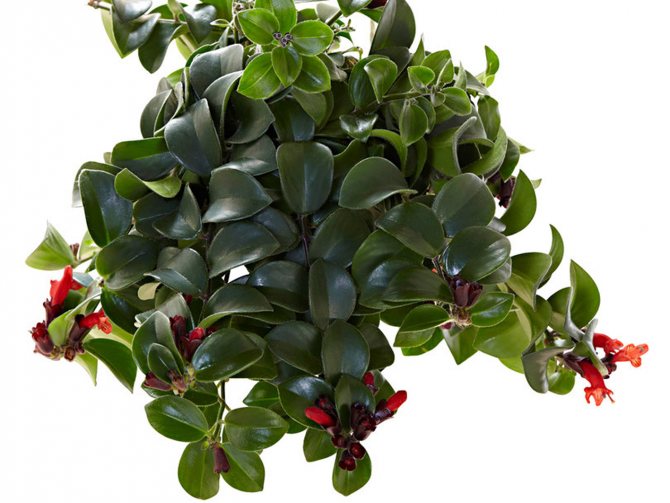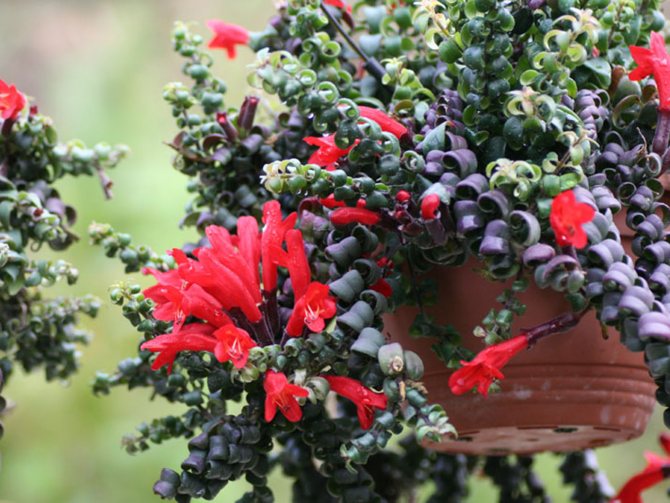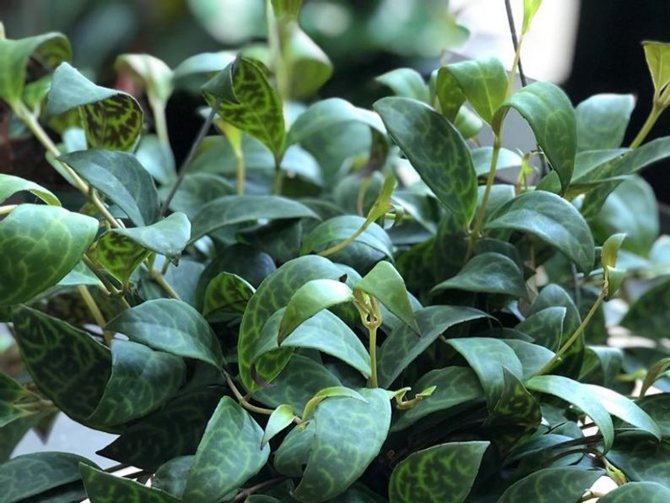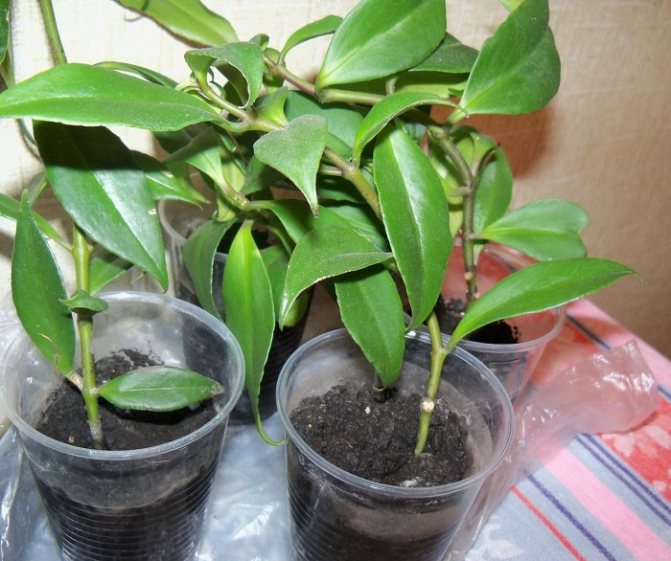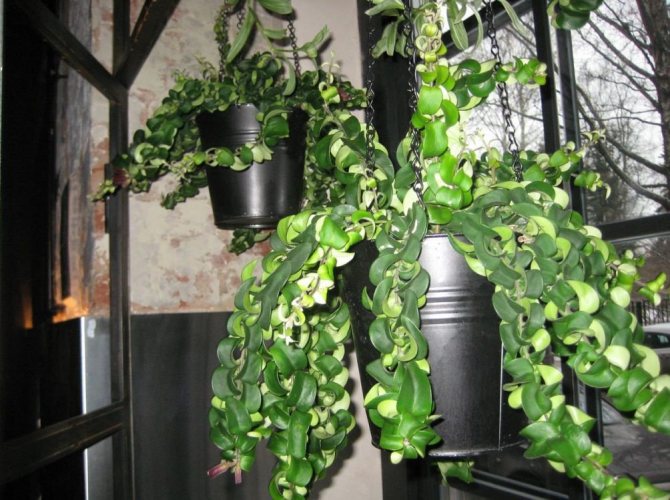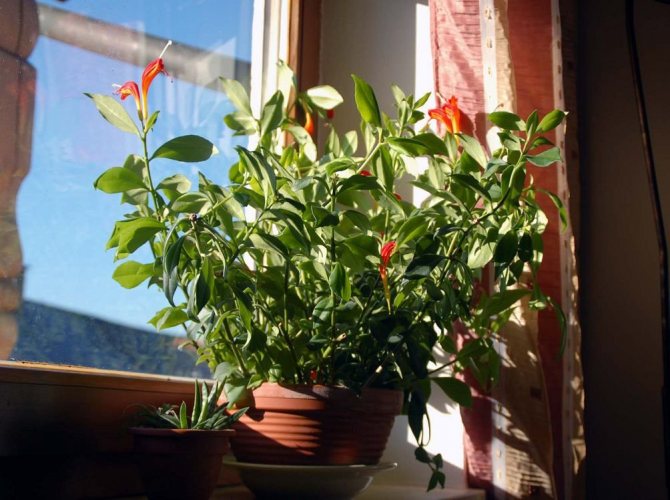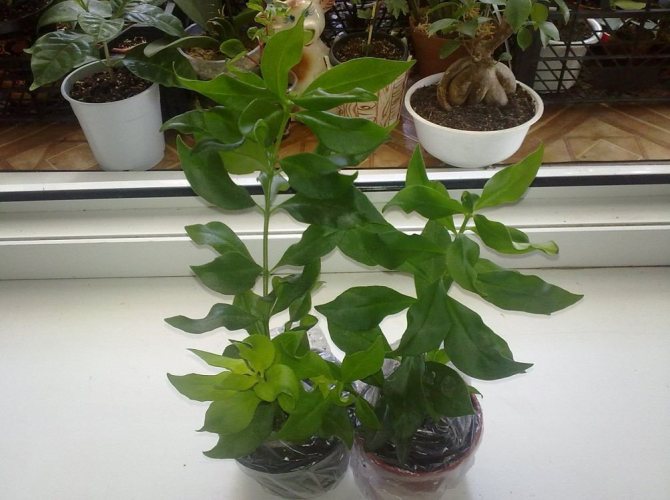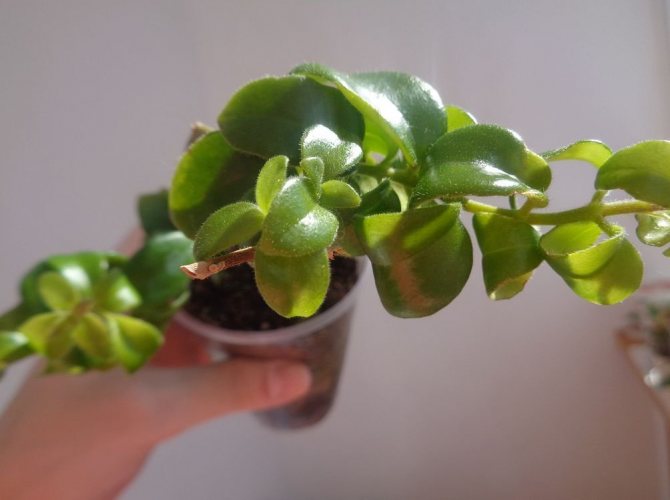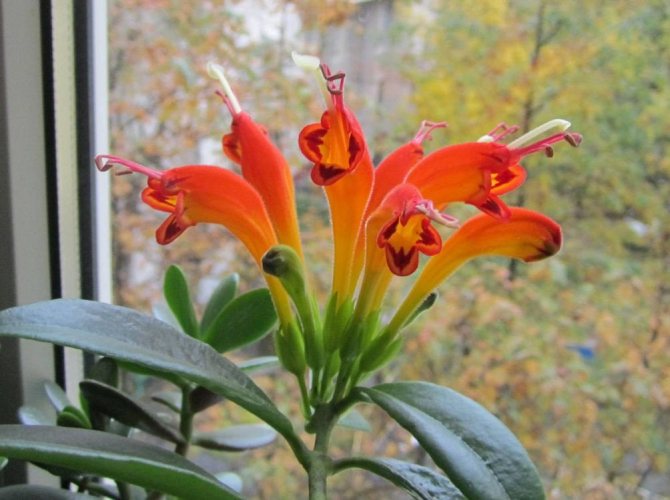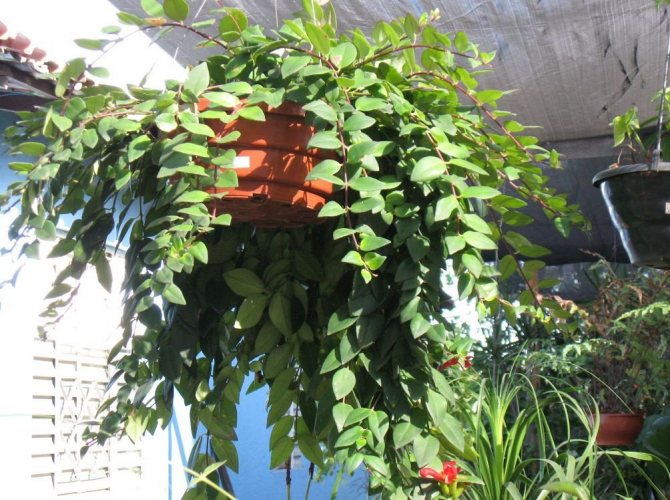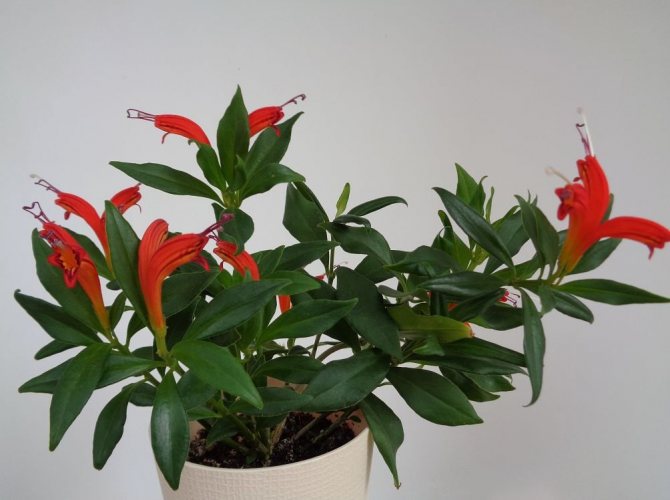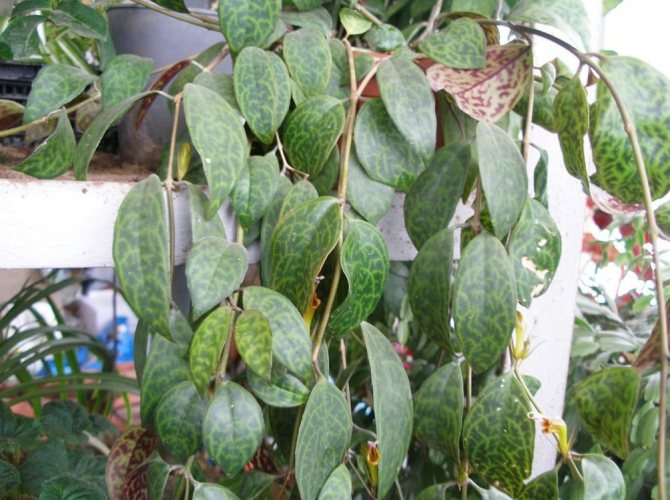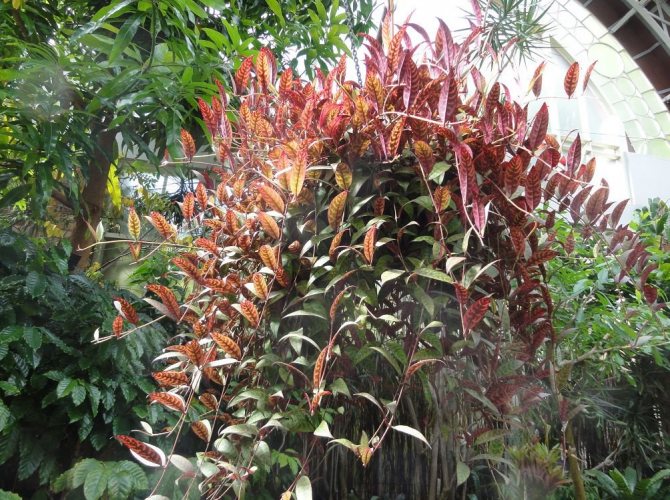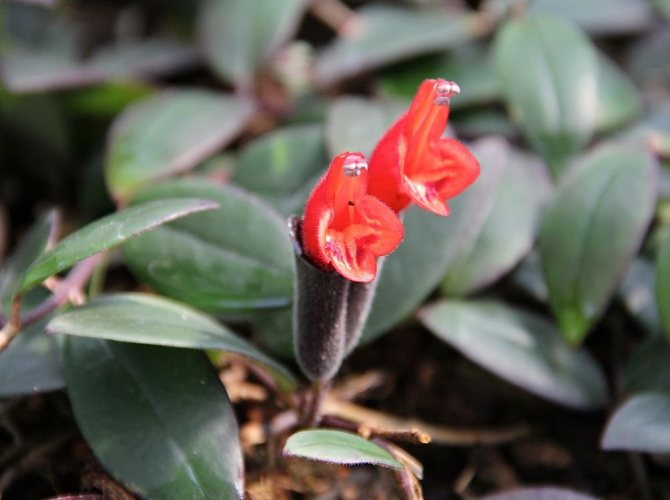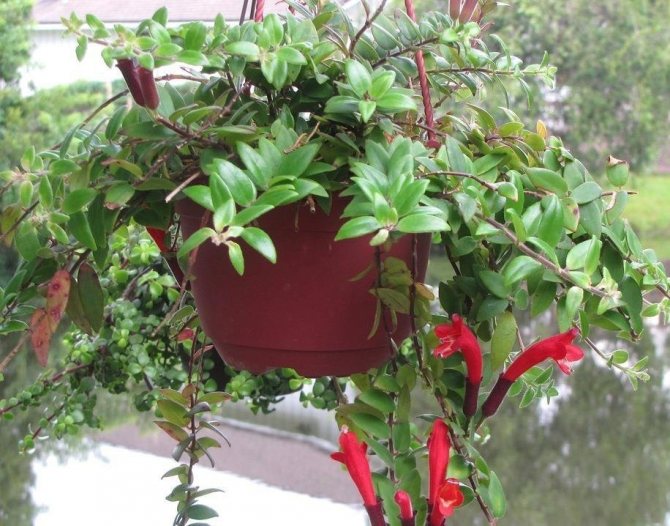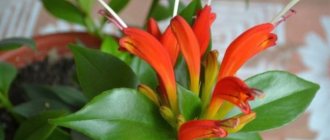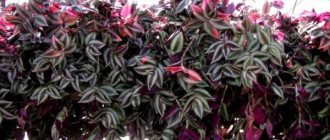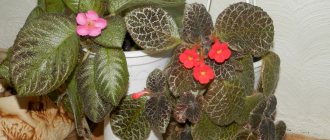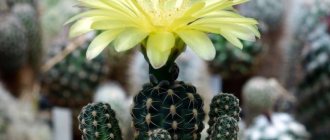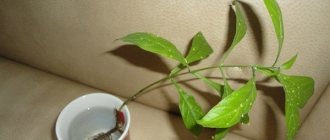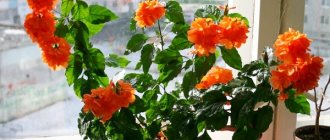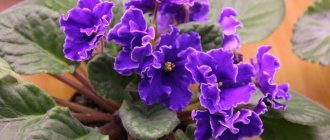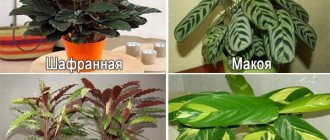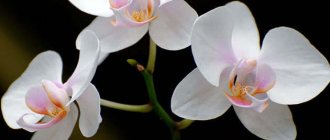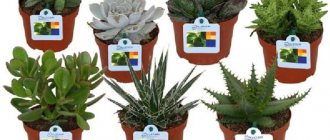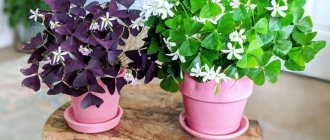Aeschinanthus is not a popular houseplant, as a lot of attention needs to be paid to the flower. Many representatives of the Gesneriaceae family, such as coleria, streptocarpus and the most famous of them among flower growers - violet, require quite serious efforts to take care of themselves, but the eschinanthus makes the greatest demands on its owner.
Despite the fact that many experienced flower growers go to almost everything to make it bloom, these efforts do not always end in success.
It is often necessary to resort to small experiments to determine what exactly the plant does not like in order for it to bloom. Nevertheless, the basic rules for caring for an escinanthus cannot be violated. These rules will be discussed in this article.
Description of eschinanthus
The genus Aeschynanthus, according to various estimates, includes from 79 to 169 species of semi-epiphytic plants of the Gesneriaceae family. Under natural conditions, they can be found in the tropics of East Asia, India and on the islands of the Malay Archipelago. The name of this plant was obtained because of its unusual flower shape: aischyneia (ancient Greek) - distorted, anthos (ancient Greek) - flower.
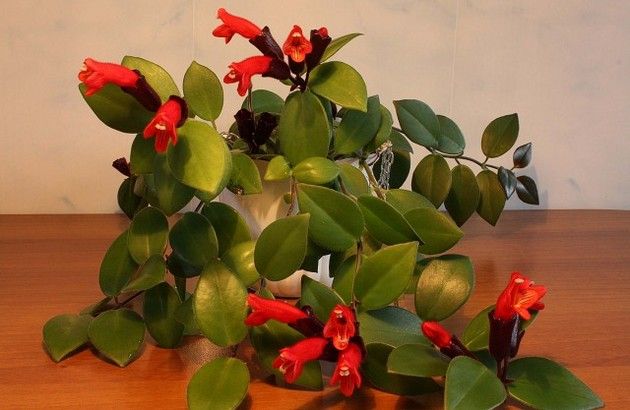
Aeschinanthus are epiphytic, evergreen, climbing or semi-shrub type plants. Their leathery, fleshy leaves grow oppositely on short petioles. Aeschinanthus flowers are located in the apical scutes or axillary type. In shape, they resemble a corolla with a curved tube, bent at the edge. Aeschinanthus bloom pleases with bright colors, orange and red. Thanks to this, the plant is highly valued for its decorative qualities.
At home, about 15 varieties of Aeschineanthus are grown, but 5 of them are most widespread.
- Long-stemmed Aeschynanthus (Aeschynanthus longicaulis Wallich ex R. Brown) has a second more popular name, Aeschynanthus marmoratus T. Moore. The plant is formed by writhing rather long stems covered with long waxy leaves. Their color largely determined the widespread distribution of this eschinantus variety. The dark green leaves are covered with a yellow-green contrasting mesh, while the reverse side is distinguished by a dark chestnut color. The tube of green flowers of Aeschinanthus long-stemmed is decorated with chocolate specks.
- Aeschynanthus lobbianus Hook. Is an epiphytic plant with rather flexible stems decorated with small, dark green, elliptical, fleshy leaves. Its flowers are pubescent, two-lipped. They stand out for their beautiful color combination: the red corolla contrasts with the creamy yellow tube.
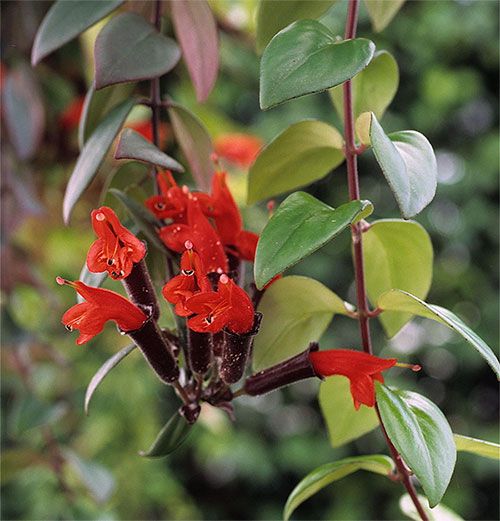

- Aeschynanthus obconicus C.B. Clarke is a bushy plant with drooping shoots. Its long (up to 4 cm in length) leaves of a pronounced elliptical shape. The burgundy calyx of the reverse conical eschinanthus flower is decorated with a dark red corolla. The calyx together with the peduncle are pubescent.
- Aeschynanthus beautiful epiphyte (Aeschynanthus pulcher G. Don) is formed by reddish stems with long oval leaves located opposite. These light green leaves are beautifully framed with a thin red stripe around the edge. Flowers are striking in their color.Their rather narrow green calyx is decorated with a bright red corolla, which becomes pale pink in its throat.
- Aeschynanthus gorgeous or gorgeous (Aeschynanthus speciosus Hook.) Is the most common species of this plant. It is widely grown in warmer greenhouses and indoors. It is an evergreen climbing epiphyte. Its stem, more than half a meter in length, is usually slightly knobby and stiff underneath. Oval-lanceolate leaves slightly toothed at the edges, located opposite. Flowers are formed on rather short pedicels, usually 10 pieces are combined in bunches. Their rather long corolla with a yellow curved tube expanding upward ends with a four-lobed red limb. Inside the pharynx, at the very base of the blades, an orange spot with a black border can be seen. When grown indoors, Aeschinanthus splendid is highly prized for its decorative qualities.
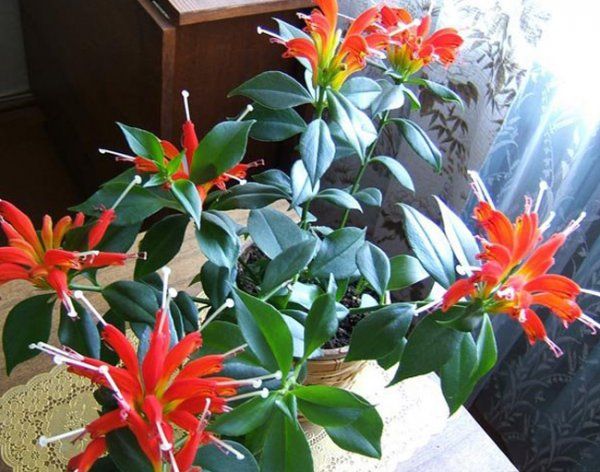

Varieties of eschinanthus
Eschinanthus the Beautiful
Aeschinanthus flower - everything about it, types of marble, Rasta, Twister, Firebird, etc.
This variety is distinguished by bright green foliage and scarlet flowers that resemble elongated tubes. The buds are formed in 9-12 pieces in a "bunch". Stems up to half a meter long descend to the ground. The growing recommendations discussed above apply here as well.
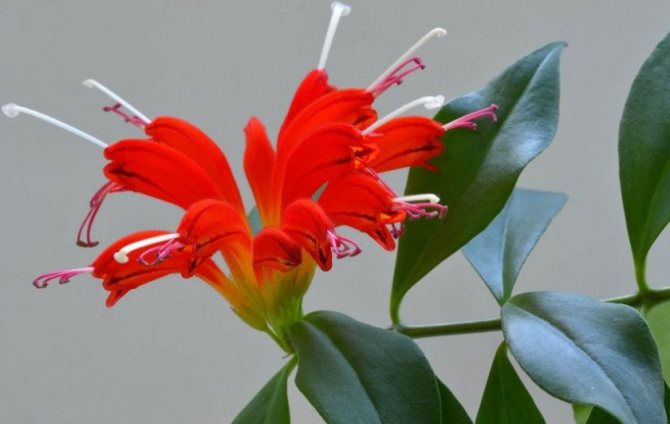

Aeschinatus is beautiful
On a note: sometimes this plant is confused with Aeschinanthus the Beautiful, but the latter has smaller leaves, and the flowers are red on the outside and pinkish on the inside.
Eschinanthus Mona Lisa
One of the most capricious, even a beginner and not yet very attentive gardener can cope with it. The species is characterized by dark emerald leaves with an almost glossy sheen. They are closer to an oval shape and are decorated with a clearly defined vein in the center.
Note! During the flowering period, with proper care, the escinanthus Mona Lisa attracts attention with the wine-red color of the petals.
Aeschinanthus Rasta
This variety attracts attention with dark leaves curved towards long stems resembling vines. When growing, it is demanding, but no more than other types of aeschinanthus.
Eschinanthus the Marble
Especially appreciated for its lighter pattern on dark lush foliage, reminiscent of exquisite marble stains. This eschinanthus looks very unusual and eye-catching, especially in a hanging planter. However, it also requires a lot of attention from plant lovers.
Eschinanthus Twister
Twister pleases the eye with strongly curved, almost curly greens of a dark shade with a waxy sheen. Flowers are rich orange with a smooth transition to red, appear only if you follow all the rules of cultivation. Looks best in hanging pots.
Whichever flower you choose, the rules of care are almost the same for everyone.
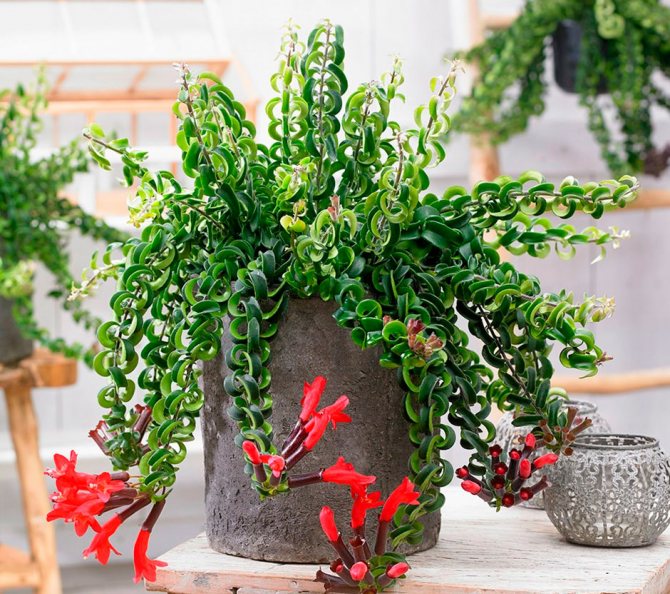

Eschinatus twister
Growing at home
Perhaps eschinanthus is not the easiest plant to handle, it can bloom profusely in one season, and not bloom at all in another. This happens because in the winter it was kept at too high a temperature. For the entry into bloom each season, Aeschinanthus needs light cooling during the dormant period, when daylight hours are shortened.
But it is a pleasure to take care of the eschinanthus and to achieve its flowering, and all the work "pays for" its bright crimson tubular flowers that appear in late spring - early summer.
Aeschynanthus speciosus is most often grown at home. This is an ampelous plant, which is most often planted in hanging pots.
The lifespan of aeschinanthus in a pot at home breeding is from 1 to 3 years. The plant is not grown for more than 3 - 4 years, it loses its decorative appearance, it is necessary to root the cuttings for renewal.
Location in the house of eschinanthus
Since the escinanthus loves light, but does not tolerate direct ultraviolet radiation, place it away from windows or choose windows on the west and east sides of the house and shade, for example, with tulle curtains.
- Eschinanthus will perfectly green any room of your house: living room, bedroom, bathroom, kitchen, nursery and even hallway.
- The only condition that a room must meet, in addition to good lighting, is a relatively high humidity.
- Therefore, the kitchen and bathroom in this case benefit in comparison with other rooms in the house.
But if the bathroom is with an insufficient amount of light, then it is better not to put the eschinanthus there, because it will not live long on artificial lighting. Eschinanthus will look great in the bedroom, in the nursery and even in the hallway. But if you decide to put the plant in the hallway, where there is little light, reanimate it from time to time - put it in lighted places in other rooms, again remembering to shade it.
lucky-
Temperature
When caring for eschinanthus, avoid sudden changes in temperature and drafts. This can kill the plant. Aeschinanthus, like all tropical plants, is thermophilic.
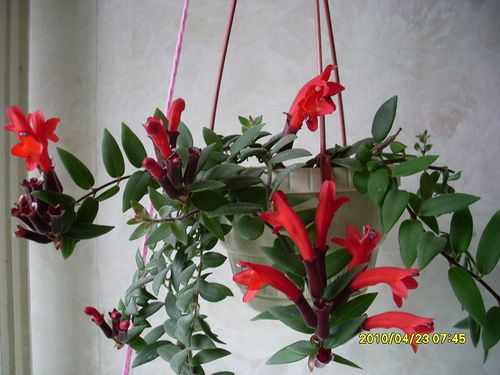

Aeschinanthus flower from spring to autumn is recommended to be kept in a room with a temperature of 23 - 26 °.
From the fall, you can slightly lower the temperature of the content.
The secret to achieving the flowering of the eschinanthus is to keep it in winter. Aeschinantus needs a lower temperature during this period. At a temperature of 15 -18 °, the probability of early bud laying, which may appear as early as late winter - early spring (February-March), increases many times over.
Temperatures that are too cold can lead to shedding of leaves.
Lighting
Indoor flower eschinanthus is a light-loving plant. He prefers a well-lit place away from direct sunlight. It is necessary for the Aeschinanthus for full flowering. Without sufficient lighting, the likelihood of flowers appearing in Aeschinanthus is reduced. On very hot summer days, Echinanthus will most likely need extra shading.
Suitable for growing on western and eastern windows. On the southern windows, the plant should be provided with shading from direct sunlight. Aeschinanthus may lack light on the north windows.
Watering
The houseplant eschinanthus is watered abundantly during the growing season, as the upper layer of the substrate dries, maintaining a constant moisture content of the compost.
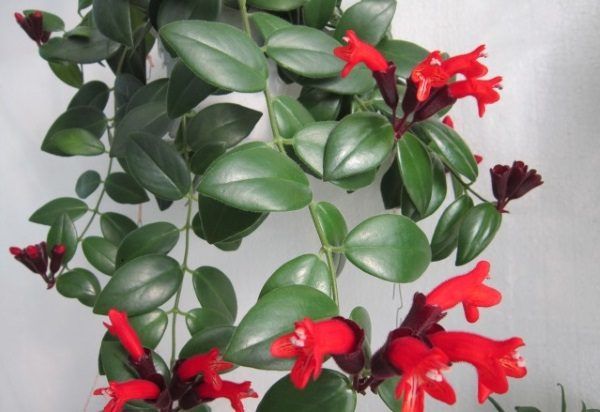

From autumn to spring, watering is reduced, watered a day later, after the substrate dries up on top. The earthen lump is not brought to overdrying, but it is not worth overmoistening too much. Overdrying, even short-term, of an earthen coma adversely affects the development of the plant, it can shed buds and flowers.
- Water for irrigation of Aeschinanthus is taken settled, soft and warm.
- The water should not contain much calcium.
- If the water in your area is hard it should be softened.
During flowering, aeschinanthus needs high air humidity, to maintain which it should be regularly sprayed with warm soft water from a spray bottle. Accordingly, the room must be well ventilated.
In winter, the eschinanthus flower is not sprayed if it is kept in cool conditions, but to increase the humidity, you can place the pot with the plant on a pallet with wet expanded clay.
Care rules
It should be noted that it is not so easy to grow, and even more so to get a flowering plant, indoors. Aeschinanthus refers to plants that require compliance with certain conditions for growing. Thanks to the beautiful foliage, Aeschinanthus is kept in offices and apartments. Several cuttings are planted in one pot to obtain a dense bush with hanging branches. The plant looks very nice in a hanging planter.Below we will tell you how to properly care for Eschinanthus in order to achieve its frequent flowering.
Lighting
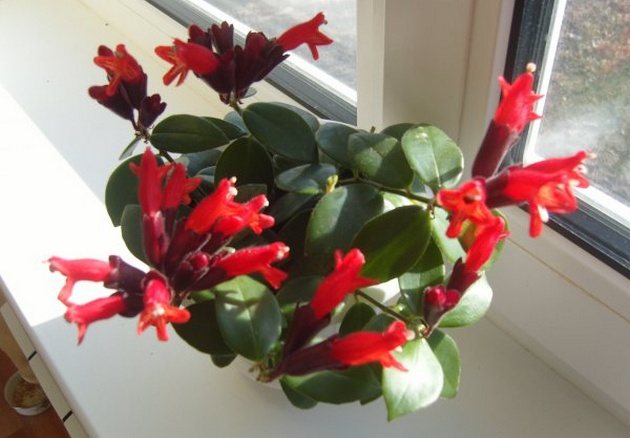

Aeschinanthus needs good lighting without exposure to sunlight. It is placed on windows facing east or west. You can put the pot on the south window, but it is necessary to shade it from the sun with a light curtain. Otherwise, the sun's rays will leave burns on the leaves. With a lack of light, the plant will not delight you with flowers. But when placed on a windowsill, it must be remembered that the flower does not like drafts, but needs fresh air.
Temperature
To obtain a luxurious flowering plant, it is necessary to protect it from temperature surges. The plant develops well in rooms with a temperature of 20 to 25 degrees. In the fall, it is necessary to ensure a slight decrease in temperature. For the plant to bloom in spring, you need to lower the temperature to 15-18 degrees. At the same time, the eschinanthus needs good lighting.
The temperature must not be allowed to drop below fifteen degrees, otherwise the leaves will begin to fall off. If the correct temperature regime is observed, flower buds will appear in late winter - early spring. You can start to gradually increase the temperature.
Watering and humidity
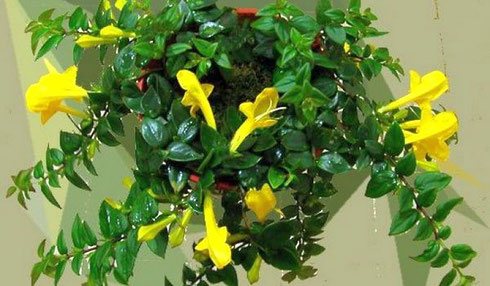

Aeschinanthus needs the right combination of humidity and watering. Water the flower only after the top layer of the soil dries up a few centimeters. Excess water is poured from the pan. If you allow the soil to dry out in a pot, then buds and flowers will begin to shatter. In summer, the flower is watered more often, and in winter - a day after the soil dries out. With excessive watering, the leaves turn yellow and crumble.
Water used for irrigation and irrigation should be:
- defended;
- room temperature;
- soft.
Hard water is softened by adding a few drops of lemon juice.
The leaves of the flower are capable of accumulating moisture, therefore they carry the dry air of apartments. But in the summer, it is recommended to spray the plant once or twice a day, avoiding moisture on the flowers. The spray water should also be warm and settled or filtered. In the summer you can arrange a warm shower for the eschinantus. In winter, the flower does not need spraying. You can put the pot in a container with wet expanded clay.
In spring and summer, Aeschinanthus needs feeding. Fertilizers are traditionally used for flowering plants, which are applied together with watering once a week. The dose of fertilizers for the eschinantus is halved.
Pruning
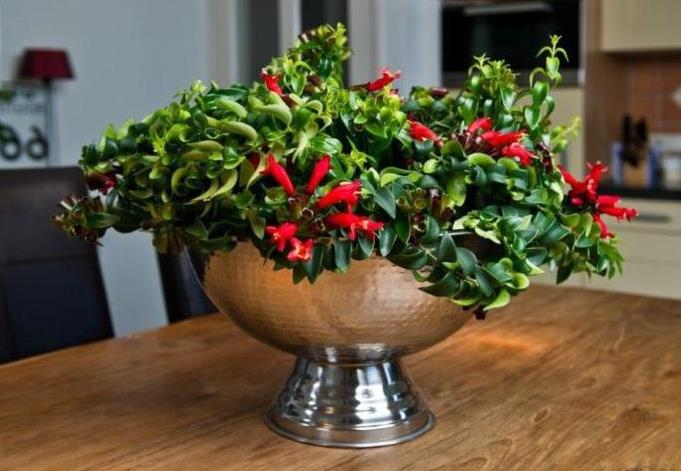

Over time, in the upper part of the plant, the leaves crumble, which leads to the loss of its decorative effect. Therefore, it needs periodic pruning, which can be done before and after the flowering period. Long shoots are shortened by one third and dry leaves are removed. You can pinch the tops of the shoots.
This may be interesting: Why Eucharis does not bloom and other problems of growing the Amazon Lily
Transfer
Aeschinanthus is transplanted by the transshipment method. This procedure is carried out before or after flowering. The new pot should be a couple of centimeters larger in diameter. A drainage layer is poured at the bottom to avoid stagnation of water in the pot.
Young plants are replanted every year. Large flowers are transplanted when the roots are visible from the drainage holes. Eschinanthus feels comfortable in tight pots.
The soil
The soil for the eschinanthus must be loose, allow air and moisture to pass through. Moreover, it must be nutritious. Therefore, it can be prepared in two ways:
Add baking powder to the ready-made commercial soil (universal):
- perlite;
- vermiculite;
- small expanded clay.
Prepare an earthen mixture yourself from the following components:
- leafy ground (2 hours);
- peat (2 hours);
- sphagnum moss (1 h);
- river sand (1 h).
This mixture will allow the roots to "breathe", the sphagnum moss will protect the roots from decay.You can add coconut fiber, shredded bark, and charcoal. It is recommended to choose a pot for a plant wide, but shallow.
Ways to achieve flowering
Aeschinanthus is a plant with character. It will bloom only in favorable conditions. But you can enjoy this spectacle for a long time: from April to September. First of all, neat buds - "cases" appear, then burgundy bracts and only then bright, velvety flowers bloom.
But if the escinanthus does not like the conditions of detention, flowering can be expected for years. Judging by the reviews, beginners in floriculture are not always able to stimulate this process. Listen to the advice of experienced florists: without regular fertilization, it is quite difficult to make escinanthus bloom.
About supports
Most species of Aeschinanthus grow fairly quickly. Their drooping shoots do not need support if the plant lives in a hanging planter or in a pot on a stand.
- But modern varieties have become more often grown in the form of bushy forms.
- The stems, elastic in youth, become brittle over time. They are easily damaged.
- To prevent this from happening, the plant will need support.
Aeschinanthus can be grown using a support, so you get a tall bush. Ideally, it should be installed during planting or transplanting the plant directly in the pot. To do this, you can use arches or circular structures made of vines or trellises made of bamboo and other materials.
Aeschinanthus shoots must be carefully twisted around the arch and tied up.
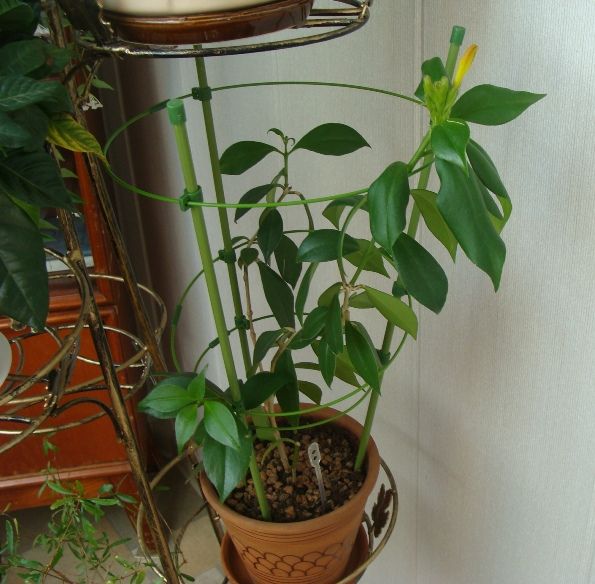

Aeschinanthus will not climb the support, its shoots must be tied up or twisted around you yourself. This should be done carefully, especially when bending the stems. They are very fragile. Florists have noticed that plants tend to curl better in a counterclockwise direction in most cases.
Humidity
The leaves of this type of indoor plants are able to retain moisture, so the plant feels quite comfortable even indoors and with dry air. Still, it will not hurt the flower if you spray it on the hot days of the spring-summer period. On the contrary, this will make its foliage look gorgeous.
It is advisable to carry out this procedure at least once a day. For spraying, use settled water at room temperature. During the procedures, make sure that drops do not fall on the buds. This makes them less attractive.
In winter, you do not need to spray the plant, but at this time it is useful to place containers with water or wet expanded clay near the pot. And despite the fact that the eschinanthus tolerates dry air well, it should not be kept near heating devices.
Reproduction
The eschinatus indoor flower is propagated by seeds and cuttings.
Seeds
Aeschinantus seeds are propagated in the same way as other Gesneriaceae.
- Dusty seeds are poured from the ripe pods onto a sheet of white paper.
- Gently tapping the leaf with your fingers, the seeds are evenly sown on a leveled and moistened substrate and covered with glass.
- Water through the pallet.
- After emergence, the glass is moved to the edge.
- Grown plants are planted in the same way as cuttings, several pieces per pot
Flowering begins the next year.
Stem and leaf cuttings
Aeschinanthus is propagated by stem cuttings (6 - 8 cm long) and leafy (the leaf is cut with one bud). The lower leaves on the handle are removed and placed in water until roots appear. You can plant cuttings in pots.
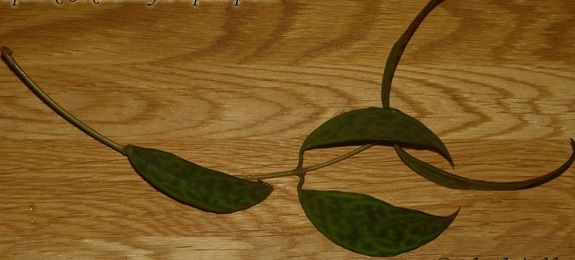

The substrate is peat mixed with charcoal. The bottom is lined with a layer of moss, cuttings are placed on top of it, then prepared soil is poured. A more successful rooting will be facilitated by a mini-plate and bottom heating, but you can simply cover it with a plastic bag. The temperature should be 26 - 28 ° C.
Aeschinanthus cuttings take root within two to three weeks.
After rooting, the cuttings are planted in pots or bowls.The substrate for the plant is prepared from crushed fibrous peat soil, fibrous sod, sand, taken in equal proportions. A layer of shards is laid on the bottom on top of a layer of sand.
Aeschinanthus propagation by leaves
Ampel plants from the Gesneriaceae family are a real decoration of any interior, especially small rooms. Very decorative, for example, pretty Aeschynanthus (Aeschynanthus pulcher, synonym - Trichosporum pulchrum). However, it is not very easy to obtain cuttings of this plant: it is still rare.
The proven and reliable method of propagation in indoor conditions - the rooting of stem cuttings - is not the only one.
Aeschinanthus can be bred with leafy cuttings, as is usually done with Saintpaulias, Gloxinia, Streptocarpus, Colerias and other plants of this family. Gesnerievs.
Cuttings are 2-4 lower leaves separated from the stem (they are always cut off and discarded when preparing stem cuttings for rooting). I put the leaves in pots with a loose substrate in a layer of washed river sand. They are installed in a small greenhouse (20-25 C).
Usually, after a month, the leaves take root and shoots appear from their base. It is interesting that on most of them the first 3-4 leaves are arranged alternately, and not opposite, as usual.
When enough young shoots are formed (when propagating by stem cuttings, there are no more than one or two), the plants are transferred to another dish. They, as a rule, have a strong root system and outrun specimens obtained from stem cuttings in development.
- Leaves need to be cut with the heel.
- Since their petioles are thin and short, for stability they must be placed in the sand and strengthened in an upright position with pieces of foam plastic, foam rubber or other material.
- You can graft at any time of the year. In winter, especially with fluctuations in temperature, the growth of Echinanthus stops, and by spring, new shoots from dormant buds resume and appear.
- Watering in winter should be very moderate, avoiding overmoistening of the substrate. In summer - more often and so that there is no stagnation of water in the trays.
Other valuable epiphytic Gesneriaceae, such as kolumneya and hypocyrtus, can apparently be bred with leaf cuttings.
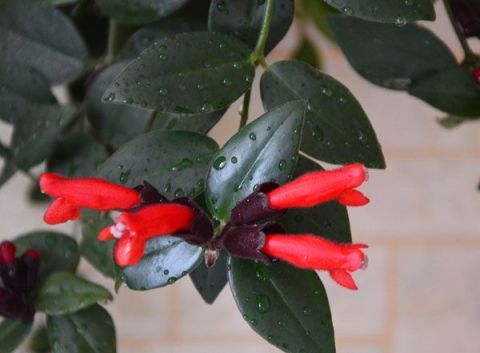

Eschinanthus: propagation by cuttings in water
Echeveria - home care and reproduction
Aeschinanthus propagation by cuttings in water is the most popular way to get a young and beautiful plant. In this case, stem cuttings are used. To get them, a section about 6-10 centimeters long is cut off from the top of a healthy and strong branch. It is important that it has five or six knots.
Note! The best time to cut is March-May (before the first buds appear) or October-November.
After removing the lower leaves, the stem is placed in a container filled with water and covered with a transparent plastic bag until the first roots appear - for two to three weeks. This process can be accelerated if the temperature is maintained at about + 25-28 degrees.
Another way to grow young Aeschinanthus is propagation by leafy cuttings, sometimes by seeds.
Thus, with a thorough acquaintance with the peculiarities of growing escinanthus, you can decide in advance for yourself whether its flowers are worth the effort. Anyone who loves original and spectacular home plants, while not afraid of difficulties, is definitely recommended to try.
Diseases and pests
The most common problems include:
- Leaves are falling. If the plant sheds its leaves in the fall-winter period, then the likely cause is too low a temperature. If Aeschinanthus leaves fall off in summer, and the substrate is dry, then the plant suffers from severe overdrying of the root ball.
- The plant does not bloom. The reason is inappropriate temperature during the laying of flower buds (should be 16 - 18 ° C).During the period of laying flower buds (December - January), it is recommended to reduce the temperature of the content to +15 - 18 ° C for 4 weeks.
- Aeschinanthus flowers turn brown and fall. During the flowering of aeschinanthus, when spraying, it is necessary to avoid getting large drops of water on the flowers, as they can turn brown and fall off prematurely.
- Leaves have light brown spots. A possible reason is too cold water, it must be warm for irrigation (20 ° C).
- Aeschinanthus leaf tips dry and turn yellow. The reason is too high temperature and low humidity.
- Aeschinanthus has a gray rot on its roots. Gray rot appears with excess moisture.
- Pests. Of the pests, Aeschinanthus can be affected by thrips, aphids and worms. The best fight against them is proper care and prevention of escinanthus.
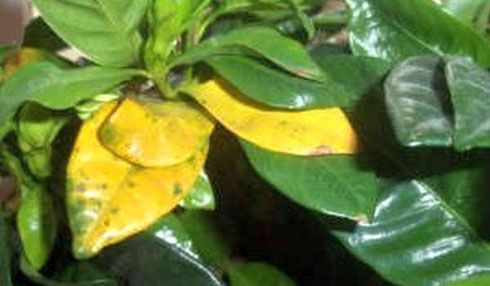

Folk recipes for pest control of eschinanthus
You can fight aphids by spraying the eschinanthus with a solution of hot pepper: 500 - 700 g of fresh hot pepper or 200 g dry, chop and boil in a small amount of water for an hour. Insist for 24 hours, then filter. Store the extract in sealed glass bottles in a dark place.
Before spraying, dilute 8-10 g of concentrate in 1 liter of water and add 5 g of regular soap. Repeat the treatment of aeschinanthus after 7 - 10 days until the aphids are completely destroyed.
Difficulties and problems in care
Often, novice florists who first bought an exotic escinanthus face problems. Suddenly, leaves begin to fall off, shoots turn yellow and dry, flowering stops. If the leaves began to fall off in winter, then the low temperature may be to blame. Falling foliage in the summer, requires adherence to the watering regime, moisture.
The reason for the yellowing and drying of the leaves is often dry air in the room. The appearance of brown or orange spots on leaf plates can be caused by sunburn or watering with cold water. The shoots have become soft, loose and watery - this is an excess of moisture in the soil.
If a the plant does not bloom for a long time, then it lacks sunlight. Often, the answer to the question - why the escinanthus does not bloom, lies in improper care, when the plant is not provided with the necessary dormancy period.
When flowering has begun, but the flowers fall off, not having time to bloom, then the plant needs good watering and moisture. We must not forget about the obligatory regular fertilization.
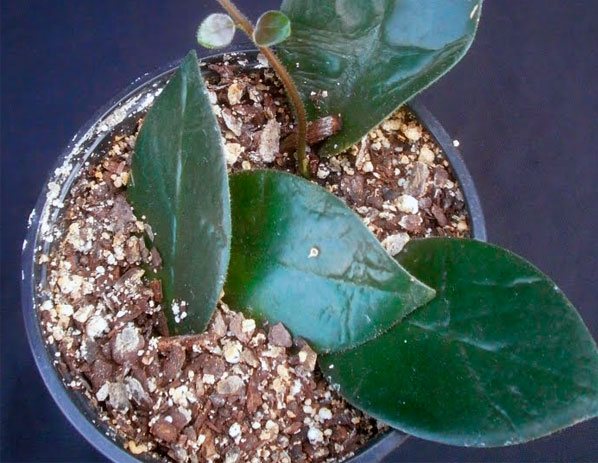

Useful tips for flower growers
Unfortunately, Aeschinanthuses tend to gradually lose their decorative effect. Therefore, after about five years, the plant should be replaced with a younger one, grown in advance from its own cuttings.
Why do the leaves turn yellow and fall, and when does he shed them at all?
After 4-5 years, the plant loses its decorative appeal, so always have young offspring on hand.
- Aeschinanthus leaves turn yellow when there is insufficient air humidity.
- This happens especially often in winter, when central heating batteries are turned on, which greatly dry up the air.
- Insufficient lighting, or, conversely, being in the bright sun can cause yellowing of the leaves in Aeschinanthus.
A plant in winter may begin to massively shed its leaves at too low temperatures or drafts arising from careless ventilation. In the summer, insufficient watering can provoke the loss of leaves.
Since the eschinanthus tends to ampel forms of cultivation, we bring to your attention a wonderful video about the features of caring for these types of plants. Happy viewing friends!
Use in phytodesign
Eschinanthus is one of the most beautiful tub plants. It is used both as a houseplant and in greenhouses and conservatories. Most often cultivated in hanging containers.The most decorative are young Aeschinanthus plants at the age of 3-4 years, as a rule, old ones, overgrown specimens are replaced with new ones obtained from rooted cuttings.
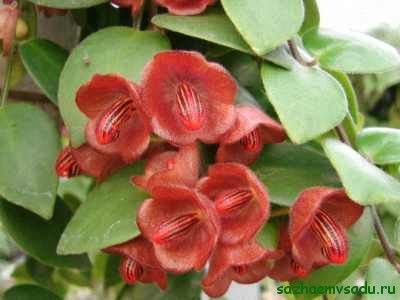

Beneficial features
Favorable energy - increases a person's self-esteem. Creates a feeling of warmth and comfort in the house.
Watering
To ensure proper care for the eschinantus at home, it is important to approach watering with all seriousness, because the plant does not tolerate both prolonged drought and excessive irrigation. Moisten the soil when it dries out to a depth of 1–2 cm. This rule applies throughout the year, therefore, you will have to water the plant more often in summer than in winter. After irrigation, be sure to drain excess water from the pan, otherwise it will provoke root rot.
For watering, use only filtered soft water at room temperature. And do not forget to let it stand for at least 1-2 days before the procedure.
Eschinanthus Mona Lisa (plant)
Description. Eschinanthus Mona Lisa
- a beautiful lush bushy plant blooming from April to August, delighting the owners with magnificent bright scarlet flowers.
Eschinantus belongs to the Gesneriev family. Plants are common in the southern part of Asia - India, Indochina, China, on the islands of the Malay archipelago.
Leaves are leathery-fleshy, opposite. The petiole is short. Flowers axillary or in apical scutes, bright red; corolla with a curved tube, with a two-lipped limb. Highly decorative plants.
- Temperature:
Not lower than + 15 ° С - Lighting:
Filtered light - Watering:
Abundant - Humidity:
High - Briefly:
Rooted cuttings flowering in season. Age 1.5-2 years old.
Aeschinantus prefers bright, diffused light. Suitable for growing by the windows of the western and eastern directions. At windows in the south, the plant should be shaded from direct sunlight. Aeschinanthus may not have enough light at the north-facing windows.
From spring to autumn, it is recommended to maintain the temperature in the room with escinanthus in the range of + 23-26C. In autumn, the temperature of the content can be slightly reduced, but not lower than 16 ° C, the spraying is stopped. During the period of laying flower buds (December - January), it is recommended to reduce the temperature of the content to + 15-18 C for 4 weeks, which has a beneficial effect on flowering. Temperatures that are too cold can lead to shedding of leaves.
Watering in the spring-summer period is carried out abundantly, as the upper layer of the substrate dries up. From autumn to spring, watering should be reduced, watered a day later, after the substrate dries up on top. Water for irrigation is taken from a settled, soft and warm. The earthen lump is not brought to dryness, but it is not worth overmoistening unnecessarily. Overdrying an earthen coma adversely affects the development of the plant, it can shed buds and flowers.
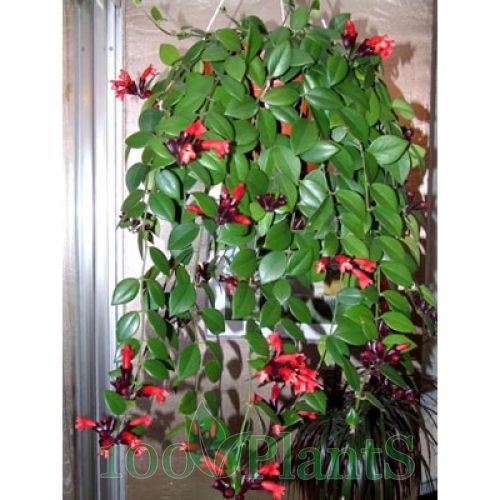

Plant homeland requirements
The humid tropical forests of Southeast Asia, where these plants come from, predetermined the requirement of aeschinanthus to high air humidity. It is useful to spray them daily from a spray bottle with warm soft water. In winter, the plant is not sprayed if it is kept in cool conditions, but to increase the humidity, you can place the pot with the plant on a pallet with wet expanded clay.
During the period of active growth - from March to September - Aeschinanthus are fed twice a month with liquid mineral fertilizers.
In the spring, the plant needs pruning and transplanting into a fresh earthen mixture. When transplanting, the pot is not greatly increased, since the eschinatuts grows better in a cramped pot; it is desirable that the new one is larger than the previous one by 1-2 cm in diameter. Semi-epiphytic natural existence explains the need for drainage in the container, a loose substrate and the inadmissibility of stagnation of water in the pot. For eschinatus, a loose, light and breathable substrate with a pH of 7.0 - 5.0 (neutral or slightly acidic) is prepared.For example, consisting of leafy earth, humus, peat and sand (2: 1: 1: 1), you can also add pieces of charcoal to the substrate and, if available, chopped sphagnum.
Aeschinanthus is propagated by stem cuttings (6-8 cm long) and leafy (the leaf is cut with one bud). Cuttings are planted in pots and placed in a distribution box. The substrate is peat mixed with charcoal; the bottom is lined with a layer of moss, cuttings are placed on top of it, then prepared earth is poured. The temperature in the distribution boxes should be 26-28 ° C.
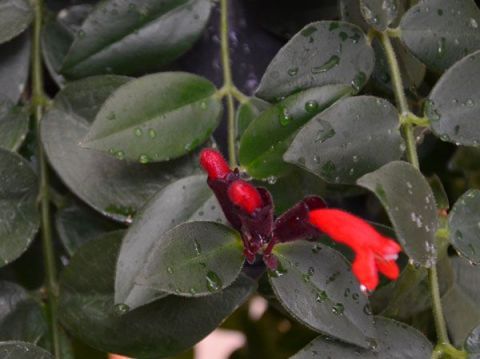

After rooting, the cuttings are planted in pots, or bowls, or wooden baskets. The substrate for the plant is prepared from crushed fibrous peat soil, fibrous sod, sand, taken in equal proportions; a layer of shards is placed on the bottom on top of a layer of sand.
Possible difficulties:
- Light brown spots on the surface of the leaves. A possible reason is too cold water, it must be warm for irrigation (20 ° C). The plant sheds its leaves. If this happens in the autumn-winter period, then the probable cause is too low temperature. If in the summer, and at the same time the substrate is dry, then the plant suffers from severe overdrying of the root ball.
- The tips of the leaves dry and turn yellow. The reason is too high temperature and low humidity.
- The plant does not bloom. The reason is inappropriate temperature during the budding period (16-18C). During the period of laying flower buds (December - January), for 4 weeks it is recommended to reduce the temperature of the content to + 15-18 C.
- During the flowering of eschinanthus, when spraying, it is necessary to avoid large drops of water on the flowers, as they can turn brown and fall off prematurely.
- With an excess of moisture, gray rot appears.
- Damaged by: aphids, thrips, scabbard mites and thrips.
www.adenium-
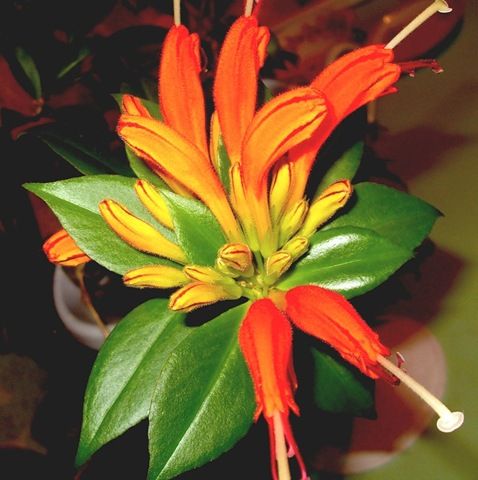

Watering and humidity
The tropical plant is very fond of moisture. This applies not only to watering, but also to air humidity. For water procedures, only thawed warm moisture is used. Before watering the eschinanthus, you need to defend the water for at least a day. Some experienced flower growers keep a special watering schedule. You can safely navigate along the top layer of the soil. If it's dry, then it's time to water the plant. It so happens that flower growers simply forget to defend the water. Then you can use filtered or distilled moisture. It is also suitable for spraying plants in the warm season.
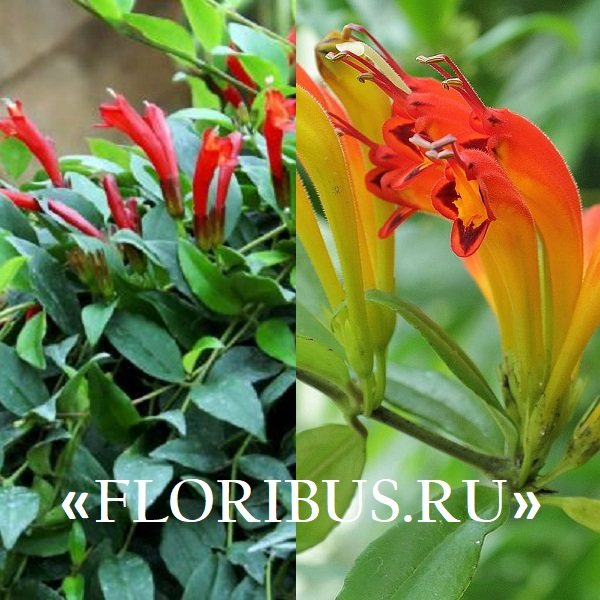

Abundant watering is necessary only in spring and summer. Closer to winter, the number of water procedures is reduced, but not completely (by about half). High humidity in the room must be maintained at all times. Often this factor is decisive in the life of a perennial. For growing escipanthus at home, both in winter and in summer, high air humidity is required - about 80-90%. It is difficult to create it in an apartment. Therefore, in a room where a tropical perennial grows, an automatic humidifier is placed or damp towels are hung on the batteries. In the summer, be sure to regularly spray the bush with melt water from a fine spray bottle.
Mineral complex compounds are used as fertilizers in a half dose. Eschinanthus is very sensitive to excess nutrients. Because of this, he can begin to shed foliage, and the rhizome will simply rot. Nutrients are applied from April to September. At this time, the plant lays new buds of growth and flowering, blooms and grows actively. Fertilization frequency - no more than 1 time in 2 weeks.
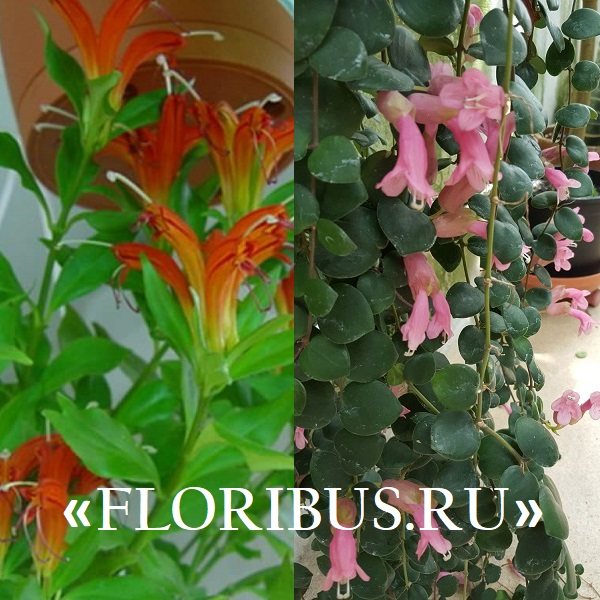

Eschinanthus is beautiful, features of care
The easiest way to look after such a representative of the Aeschinanthus as Aeschynanthus speciosus (eschinantus the beautiful), and if you follow the simple instructions and tips, this flower will delight you with the bright colors of its flowers throughout the entire spring-summer period.
At home
Like the long-stemmed eschinanthus, Eschinanthus beautiful has large flowers and leaves, but for their normal growth, it is necessary to comply with some environmental requirements:
- In the room, the temperature should not fall below 20 degrees and not rise above 25 degrees. In winter, when aeschinanthus is at rest, the lower threshold can be 15 degrees Celsius.
- Flower does not require intensive watering: just water it as the potted soil dries up.
- During the flowering period, fertilizing with mineral fertilizers is required.
- Eschinanthus does not tolerate direct sunlight, but such a flower will feel bad even in the shade.
- It is better to use special ready-made mixtures containing charcoal or chopped sphagnum as soil; in this case, it is necessary to make drainage in the pot, the thickness of which should be about two centimeters.
How to propagate and transplant eschinanthus at home
As with all houseplants, the escinanthus needs to periodically change the soil and pot. Over time, the roots grow, and they become cramped in the old flowerpot. If the roots stick out of the flowerpot, it's definitely time to start a transplant.
How and when to transplant
Young flowers need to be transplanted annually, and adults are transplanted no more than once every four years if the flowerpot has become too cramped. A new container is selected 3 cm larger than the old one. The selected flowerpot should be boiled or doused with boiling water. To make it easier to remove the plant, it is watered about 30 minutes before the start of the procedure.
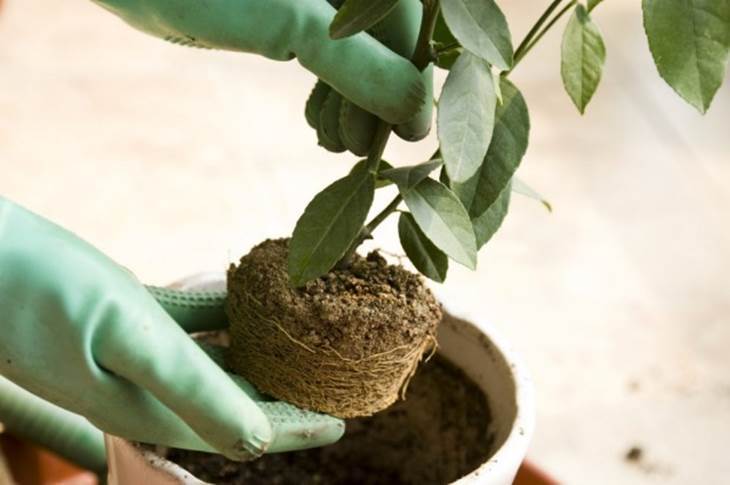

Transfer
Healthy plants are transplanted using the transshipment method. If rotten roots were noticed, then they must be removed with a sterile instrument.
The bottom of the flowerpot must be covered with a layer of drainage, after which fresh soil is prepared. You can use purchased substrates, or you can prepare a pot filler yourself from the following components:
- 30% of peat and leaf soil;
- 20% sphagnum and sand.
An earthen lump with a plant is placed in the center of a new flowerpot, and the remaining voids are filled with fresh soil.
Seed propagation
The plant is propagated in the spring and summer by seeds or cuttings. For seed propagation, the prepared soil is moistened with settled water, the seeds are placed in it and covered with glass. In order not to disturb the greenhouse microclimate, planting material is watered through a pallet.
A month later, the first sprouts appear on the surface, which are gradually accustomed to indoor conditions. It is advisable to plant young seedlings in several pieces in one flowerpot, which allows you to create a lush bush.
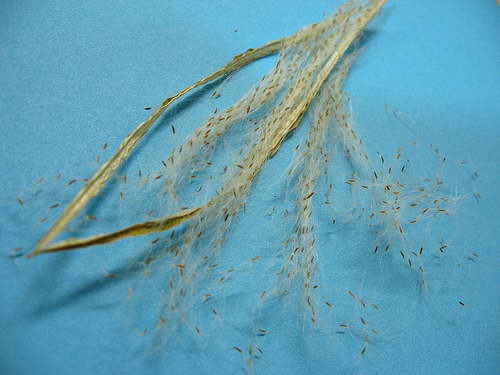

Aeschinanthus seeds
Cuttings
Cuttings can be cut with the onset of spring. The longest stem is cut off with a sharp sterile instrument and divided into cuttings, the length of which should be about 10 cm. Each cutting must have at least 5 nodules. Further, the procedure is carried out as follows:
- the lower leaves are removed from the cuttings;
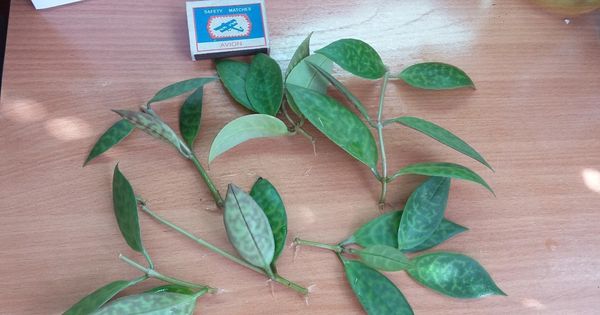

Cuttings - prepare a substrate, which should contain two identical parts of sand and peat;
- the cutting is treated with a growth stimulant (Kornevin) and deepened into the container until the first leaf;


Cuttings - the pot is covered with a bag and transferred to a warm room, the temperature of which should be within 24˚С.
Rooting takes place over three weeks. If new leaves appear on the handle, the reproduction procedure was successful.
The package from young plants is removed gradually: first for several hours a day, and then completely removed.
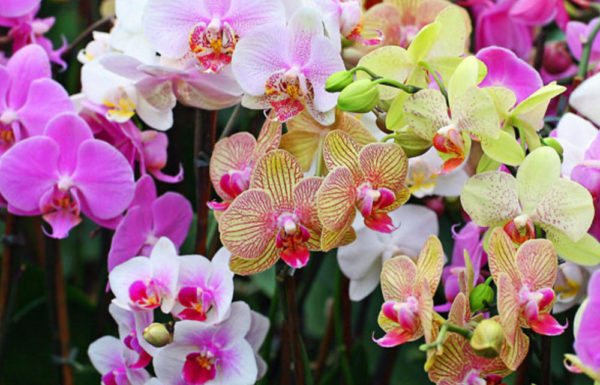

You may be interested in:
Phalaenopsis orchid: reproduction at home There is an opinion that the reproduction of phalaenopsis at home is considered a rather complicated process. However, ... Read more ...
Flower diseases
Aeschinanthus beautiful has many "enemies", the main of which are aphids and thrips. Aphids settle between leaves, as a result, in place of these colonies, the stems turn pale, and the buds will not bloom.A simple recipe will help to get rid of aphids: a cotton pad or a swab moistened with alcohol is used to wipe the areas of aphid accumulation, after which these places are additionally treated with a solution of actellic and water (20 drops of the agent are added per liter of water).
Also, Aeschinanthus often infects mealybugs, spider mites, fungal diseases and gray rot. In most cases, these pests appear due to low air humidity... They can also be dealt with by processing actellik, but it is better to prevent their appearance initially: for this, it is enough to remember to regularly spray the flower with water with insufficient moisture.
But excessive humidity and dampness contribute to the appearance of fungus and gray rot, therefore optimal conditions must be observed and avoid mistakes in care. Sometimes the flower is sick even in the absence of pests.
So, when watering with too cold water, light brown spots may appear on the leaves, and at too high temperatures and a lack of moisture, the tips of the leaves will turn yellow. If the plant freezes, it begins to shed its leaves (this happens especially often in autumn and winter, if the pot with eschinanthus is on the windowsill and is blown through by a draft from the cracks).
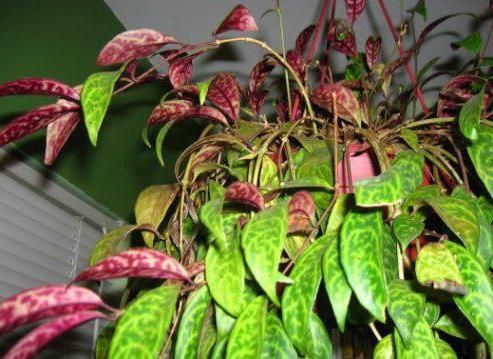

Sudden temperature fluctuations in any direction will always lead to the dropping of buds and flowers that have already appeared, but this can also happen if, after the appearance of buds, the flower is rearranged to another place or rotated relative to the light source.
Please note that between December and January, flower buds are laid in the eschinanthus. During this period, the plant does not need to maintain high temperaturesMoreover, it is advisable to place the plant in conditions where the temperature will fluctuate in the range of 15-18 degrees Celsius. If this condition is not met, there is a high probability that the escinanthus is beautiful. will not bloom in spring.
Where to place the flower
Indoor escinanthus belongs to light-loving plants, but direct sunlight is contraindicated for it. Therefore, it is advisable to place the flower near the western or eastern window. If only the southern windowsill is free, then do not be upset, because you can grow your pet here too. True, in this case, one must not forget to shade the plant from the midday rays of the sun. To do this, pull the curtains, or hang gauze or tulle over the pot.
But on the north side, it is unlikely that it will be possible to grow escinanthus, because here the flower will suffer from a lack of light. And without additional illumination with a photo lamp, the tropical beauty will quickly fade.
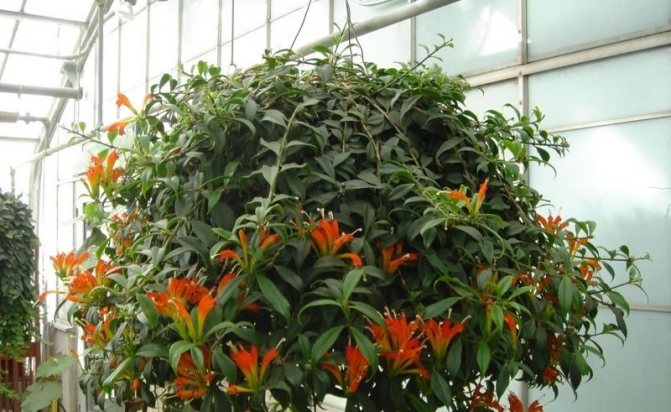

Aeschynanthus Carolina (carolyn) (Aeschynanthus)
Diameter - 15cm. Height - 50cm.
Eschinanthuses are great for creating vertical landscaping - phytosten
Eschinanthus Carolina
Recall that:
- Aeschinanthus are one of the closest relatives of violets and gloxinias adored by many flower growers;
- in the specialized literature on floriculture, eschinanthus can be found under the name "trichosporum", and in sources for a wide range of readers the name "bird of paradise" is sometimes used;
- flowers of this plant are formed in the leaf sinuses;
- at home, the blooming escinanthus is pollinated by small birds.
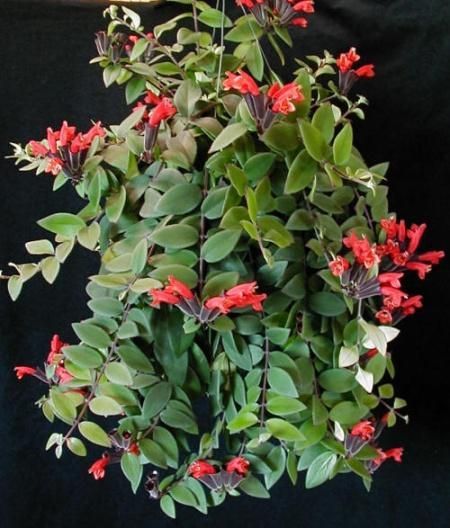

Aeschinantuscommercially available today are varied, they differ in the shape and size of leaves and flowers, some species "bush", while others - "weave". What is so good about Carolina?
Eschinanthus Carolina - one of the best plants for ampel. Small leathery leaves combined with bright red flowers are very decorative. Carolina blooms several times a year, the dormant period is very short (usually in December-January). The plant is so lush that you don't even need to think too much about whether the new hanging pot will fit into the interior: it will still not be visible under the numerous green shoots of Aeschinanthus! Its fleshy leathery leaves are opposite on a small petiole. The flowers form the inflorescences of the shields. The plant blooms in spring, summer and autumn.
Location.
The rooms for this flower should be bright, but without the sun.
Temperature.
The optimum temperature for Aeschinanthus is considered to be 22-26 ° C, in winter and autumn - no more than 16-18 ° C.Before the appearance of the buds, 4 weeks before that, the plant is kept at a temperature of 14-19 ° C (December and January).
Watering and moisture.
It is impossible to overdry or fill the soil, but in the warm period, watering is done abundantly, and in winter - humid-moderate.
Plant it is very hygrophilous, so it is sprayed every day in warm weather, and in winter - only the air near it.
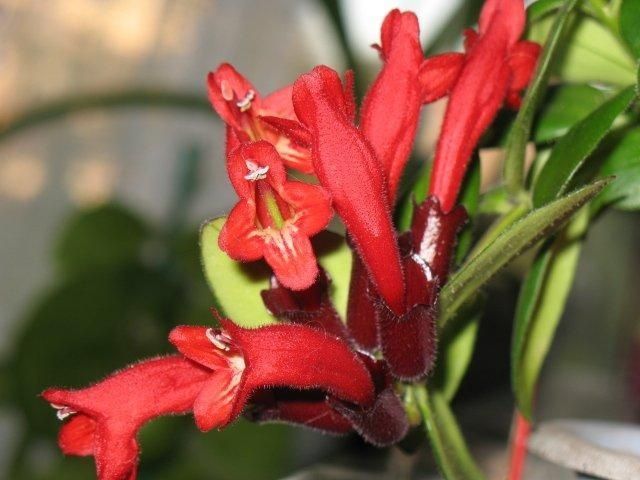

Fertilizer.
The most acceptable top dressing is a complex of all mineral fertilizers with which it is fertilized from the beginning of March to September. Our
online store has all the necessary complex fertilizers, soils, substrates and other substances and additives necessary for each plant, which can always be buy from delivery by Moscow. Reproduction and transplant.
The transplant is always carried out in the spring, as needed. At the same time, you can plant Aeschinanthus using cuttings and seeds.
Aeschinanthus flower. Description, features, types and care of Aeschinanthus
"Distorted Flower". This is the translation from the Greek of the name of the flower Eschinanthus... The corolla of its bud is asymmetrical. By the way, there are a lot of flowers. They are tubular, collected in a single composition, reminiscent of an umbrella.
Hence the term "umbrella inflorescence". Long tubes of ovaries protrude from it. This creates a "cloud of filaments" around the inflorescence. They are white and the petals are bright.
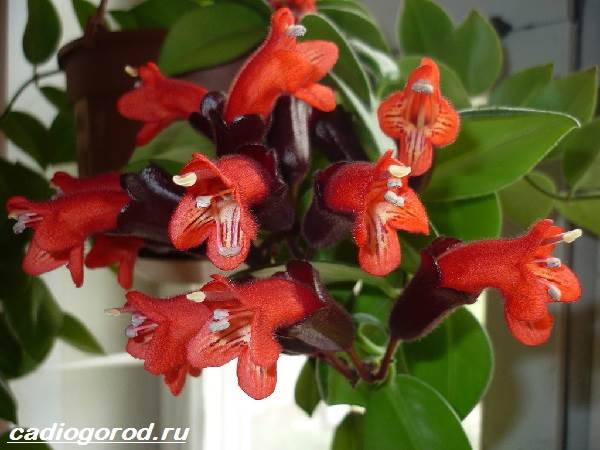

Due to the spectacular colors Eschinanthus in the photo on the Internet - a typical model. However, in reality, few contain the plant. The answer to the question of what this is connected with, look in the article.
Description and features of Aeschinanthus
The hero of the article belongs to the Gesneriev family. There are 160 genera in it. Most are welcome in greenhouses and gardens. The bright color of the corollas is typical for many Gesnerievs, for which they are appreciated. Only in the form of growth Aeschinanthus flower ampelous.
So, without props, the hero of the article hangs freely from the pot. This "draws" a parallel with ivy. It is considered a widow's flower. The fame spread to Eschinanthus. Beautiful the bush is believed to scare off men. They leave families, or do not become part of them.
It is no secret that there are many women among flower growers. Superstitions associated with Aeschinanthus make them abandon the flower, not acquire it. Meanwhile, the hero of the article is not only beautiful in the buds, but also in the leaves.
They are as if varnished, dense. Botanists call such plates leathery. Their shape is oval. The edge of the sheet is even. In a number of Aeschinanthus varieties, the green plates are also variegated.
They are often planted to form a lush crown. The abundance of shoots falling from the pot forms a kind of ball. It comes from Aeschinanthus's ability to branch. A voluminous bush is obtained from just a couple, three branches.
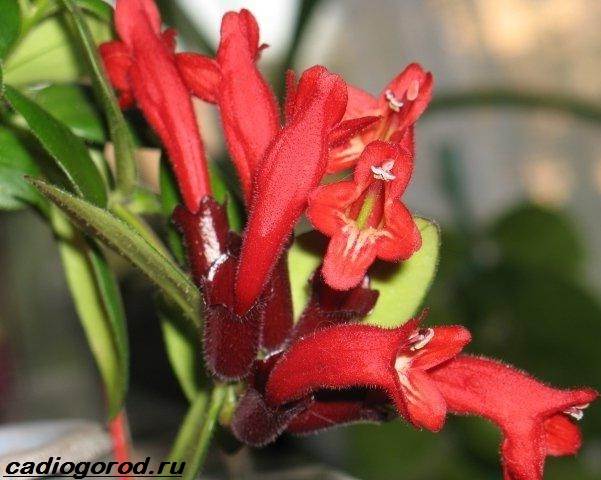

In the photo Eshinanthus Carolina
Trunks indoor flower Eschinanthus has flexible, like lianas. However, the latter are always directed upward, striving for the sun. The hero of the article needs it less. It grows quietly in the opposite direction from the light.
This is the "policy" of Eschinanthus not only at home, but also in nature. There, the hero of the article took a fancy to the south of Asia, populating tropical forests. In them, the plant is fixed on mossy stumps under a canopy, or on living trees.
They are just a support. Aeschinanthus does not feed on the juices of other plants, snatching the necessary substances from the soil with the help of underground roots reaching it and from the air with the help of stem processes.
Plants settling on others and asking only for "shelter" are called epiphytes. Such is the Eschinanthus. At home he is content with an ordinary pot. In greenhouses, the natural growth of the flower is often supported by planting it on large trees.
In indoor conditions, the stems of the hero of the article rarely grow to a meter. In nature and greenhouses, there are 1.5 and 2-meter shoots. At the same time, the leaves stretch by 8-13 centimeters, being about 3-4 in width.
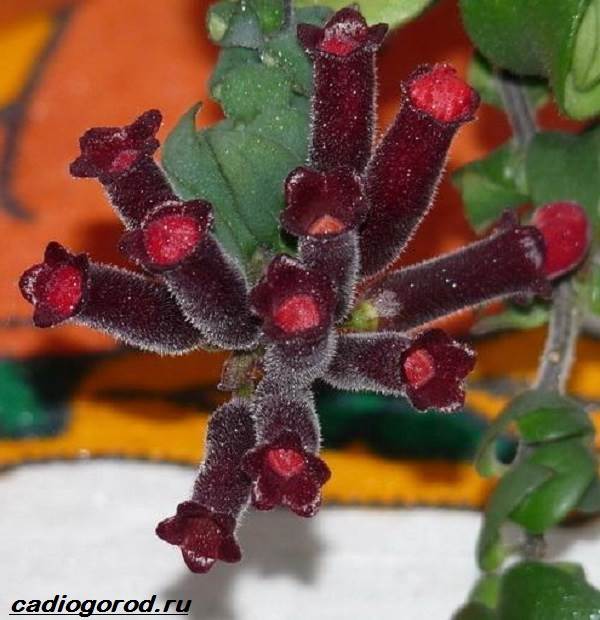

In the photo Eshinanthus Rasta
The length of the buds of the hero of the article varies within 3-10 centimeters.Most of the Aeschinanthus varieties are red or burgundy. This and the tubular shape of the buds is the reason for the second name of the flower. He is called Lipstick, which translates as "lipstick". Each bud of Eschinanthus is like a tube from Dior.
Reproduction and planting of Aeschinanthus
Reproduction of Aeschinanthus it is customary to carry out cuttings. Take the tops of the shoots of the flower. Those that are detached in spring and summer take root better. Slices with 2 growth nodes are enough. They are immediately placed on the substrate. If you want fast rooting, you can treat the cuttings with a growth stimulant.
The substrate for the rooting of Aeschinanthus consists of equal proportions of peat, sand and sphagnum, that is, moss. In them, cuttings take root under glass or polyethylene caps.
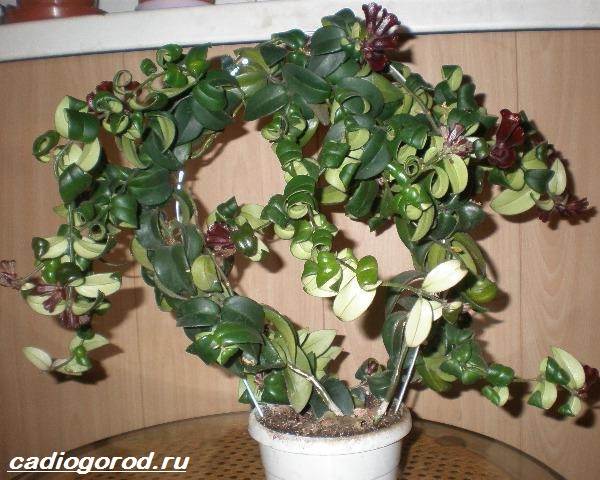

In the photo Eshinanthus Twister
Shelters help keep the pot at a 25-degree temperature and high humidity. The shoots are given to drink through the drainage hole of the flowerpot, that is, pouring water into the pan. They remove the film only when Aeschinanthus gives roots and grows.
A less popular way of reproduction of Aeschinanthus is by seeds. They are rarely sold due to their short shelf life and low germination. It is difficult to collect your own material, because the hero of the article rarely blooms at home. Plus, pollination is required. We have to carry it out artificially, using soft brushes.
Sow the seeds of Aeschinanthus on a substrate of equal proportions of sand and peat. The soil must be moist. It is not necessary to bury the grains, just press them slightly into the ground. As in the case of cuttings, it needs to be covered with foil.
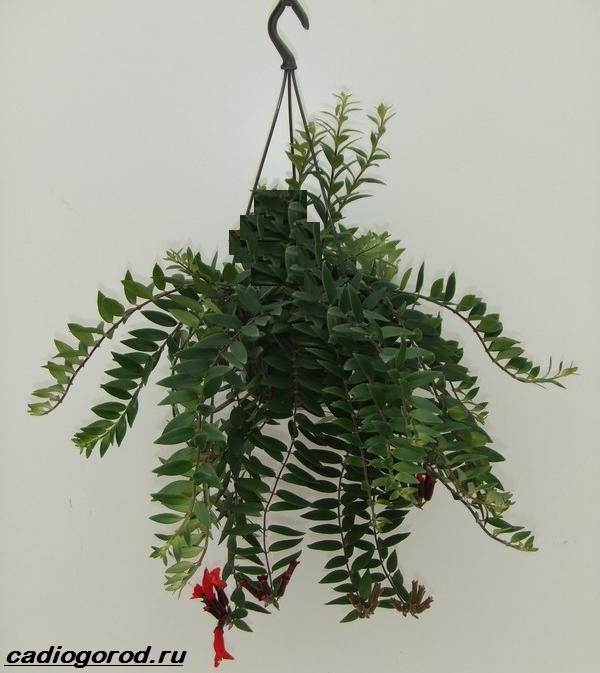

In the photo Eskhinanthus Yafrolepis
They remove it a couple of weeks after germination of the seeds. If before that they need watering, water is given through the pan of the pot. By the way, they keep it not only in a warm, but also well-lit place.
When the seedlings of Aeschinanthus grow up, they are seated in separate pots. In one, 2-4 pieces will interfere. This ensures the formation of a lush bush. If the hero of the article is bought in a flower shop, a transplant is required.
It is carried out by the transshipment method. In other words, the roots of the plant are not freed from the earth, but only slightly shaken. Getting into a new pot with part of the old soil, Eschinanthus gets a new one only at the edges of the flowerpot. This minimizes trauma to the root system of the grass, but it also provides new resources for growth.
Aeschinanthus care
In its natural environment, Aeschinanthus is not only tropical, but also a coastal inhabitant. Climbing into the jungle, the flower seeks out reservoirs there. On their shores, the humidity is even higher than on the rest of the tropics.
Therefore, vapors in the air are the main request of the hero of the article at home. Aeschinanthus care comes down to repeated spraying, washing the flower under the shower, placing a humidifier or a tray with evaporating water next to the plant.
It is possible to avoid the emphasis on humidity only in houses without central heating, but warm and standing near water bodies. The climate of the seaside regions is ideal. However, in Russia they are cooler than in the tropics in southern Asia.


In the photo Eshinanthus marble
Eschinanthus loves temperatures from 20 degrees. 23-25 are ideal. In most Russian regions, it is possible to combine them with high air humidity only in summer, and then before and during rain.
The minimum temperature for keeping Aeschinanthus is 13 degrees. The hero of the article in February needs them. This is the period of rest of the grass, without which you will not see blooming eschinanthus.
Problems with budding the hero of the article also arise when the light regime is violated. Avoid direct rays. They burn the leaves of Aeschinanthus. But, and he should not be in the shadows. The grass loves bright, but diffused light.
Given the flower's tropical origins, it needs a long day. In winter, you have to highlight the plant. Otherwise, especially in warmth, the shoots of Aeschinanthus stretch out. The increased distance between the leaves makes the bush half-naked.
The second reason for the rare presence of Aeschinanthus at someone's home becomes clear. Not only superstitions are frightened off, but also the whimsicality of the flower. Water the hero of the article about 2 times a week. They are guided by the drying of the top layer of the earth.
It should be drained by no more than a third. Overflow is also harmful, fraught with decay of the roots of the flower. If water remains in the pan, it is drained. The liquid is used purified. Defend the water for 1-2 days, giving the plant slightly warm.
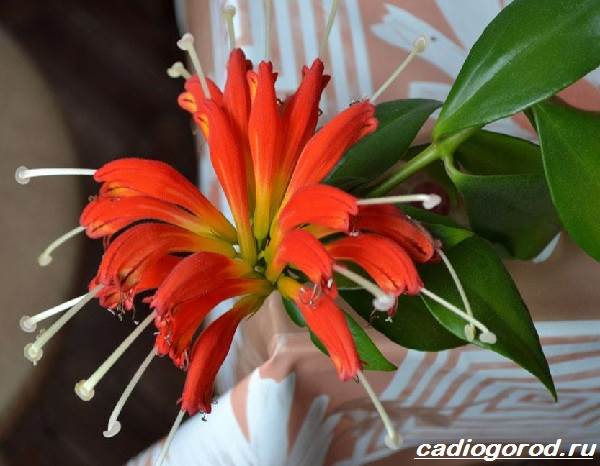

In the photo Aeschinanthus the Firebird
Fertilizer Eskhinanthus needs during the period of active growth, flowering. Mineral complexes are introduced from May to September. One feeding per month is enough. In this regard, Aeschinanthus's requests are tolerable.
Types of Aeschinanthus
I grow 6 species in culture Eschinanthus. "Beautiful"Is the first of them. He is medium in size. Shoots do not exceed 50 centimeters. The base of the stems stiffens with age.
The foliage of the "Beautiful" species is bright green. In comparison with the growth of the plant, the plates of greenery are large, about 10 centimeters in length and 3 in width. Up to 12 centimeters in length and 4 in width, the figures reach the "Beautiful" Aeschinanthus.
Another type of the hero of the article. It is similar to "Beautiful" not only in name, but also in appearance. In addition to the size of the leaves, the difference lies in the number of buds in the inflorescences. The "Beautiful" varieties combine 10-12 colors. The "Beautiful" Aeschinanthus has less "fudge" in the umbrella.
The third type of herb cultivated at home is Eschinantus "Marble"... Named for the color of the leaves. They are dark green, but covered with light yellow spots. The drawing resembles a pattern on marble. But, the back side of the green plates copies the rock even more. It is brownish with cream-white stains.
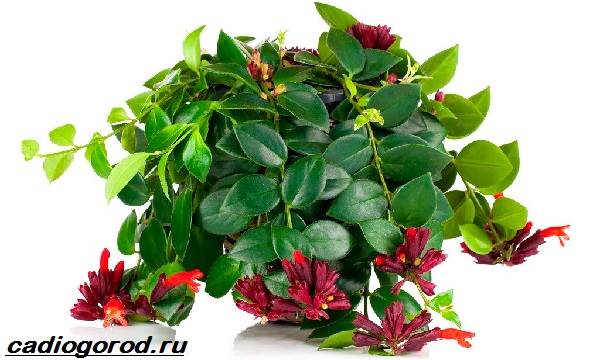

In the photo Aeschinanthus Mona Lisa
To grow a spectacular bush "Marble" Aeschinanthus, one cutting is enough. Plants of the species give many lateral processes. The "Marble" grades do not exceed 70 centimeters in height.
The fourth type of hero of the article in culture is Eschinanthus "Mona Lisa"... The artistic name is justified by the spectacular contrast of bright green leaves and deep red flowers.
Thanks to the latter, the herb is often called "Eschinanthus-Zharptitsa"... However, most fans of the species appreciate something else. Of all the Aeschinanthuses, the Mona Lisa is the most unpretentious.
The same cannot be said about varieties of the "Twister" type. They "take" with an unusual appearance. The leaves of the species are curled. The bush looks curly, like in curlers.
Thanks to the curl Eschinanthus "Twister" becomes accents in flower arrangements, home gardens. The leaves of the plant are elongated. They contain a minimum of roundness characteristic of the hero of the article.
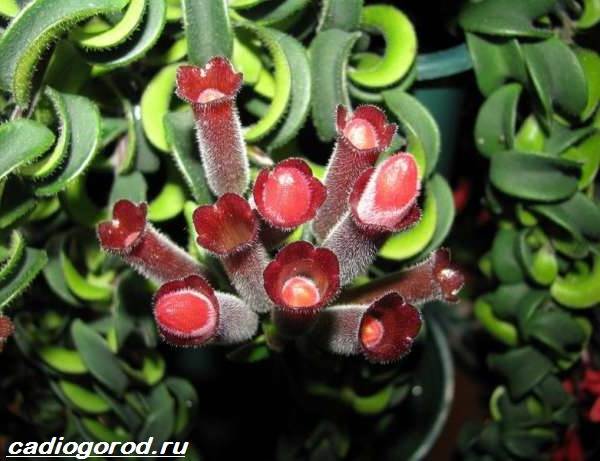

In the photo, Aeschinanthus Twister blooming
This is such a special view, however, like the "Carolina". The sixth variety of grass also distinguished itself by the plates of greenery. They are densely pubescent, like velvet. Differs in "Carolina" and the burgundy color of the cups of the buds. For this popular variety Eschinanthus "Takka", for example, they call it "Wine".
Diseases and pests of Aeschinanthus
Of the fungal diseases of the hero of the article, gray rot affects. Its pathogen is contained in the soil, but it becomes dangerous for Eschinanthus only with waterlogging and drafts. Changes in temperature and excessively wet soil lead to softening of the roots and bottom of the stems.
The fungus penetrates into loose tissue. A semblance of mold appears on their surface. The formation is gray, hence the name of the disease. It is necessary to adjust the temperature regime, reduce watering and treat the bush with "Fundazol".
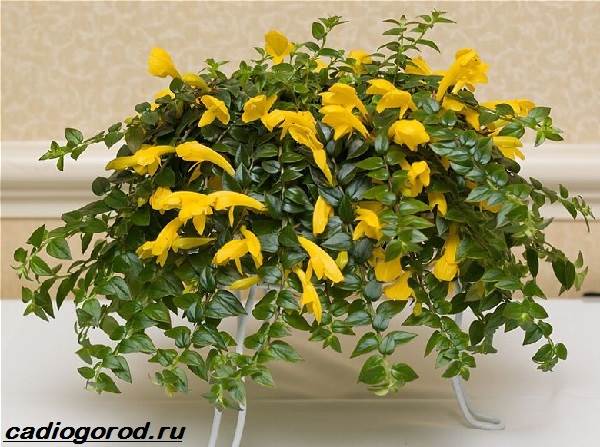

In the photo Echinanthus yellow
Of insects, Aeschinanthus is harmed by spider mites and thrips. The latter are the worst pests. They are removed only with insecticides. A characteristic sign of plant damage is multiple punctures along the edges of its leaves.
These are traces of the proboscis of thrips. They drink the juices of Eschinanthus. The spider mite does the same.But, it is smaller in size and survives from grass by folk methods. It is often enough to spray the bush. The tick only settles in a dry environment.
Also, the insect does not tolerate heat. You need to bathe the hero of the article under 45-degree water. For greenery, the temperature is normal, but for a tick it is critical. After the procedure, you can cover the bush with a bag. This will create a greenhouse environment where moisture and heat are in one "bottle".
How to avoid ailments
To prevent the plant from becoming a victim of insect pests and not getting sick, eliminate mistakes in the growing process. However, even the most caring flower growers are not immune from these problems. How to recognize the disease by symptoms and choose the right treatment?
- Small insects and spider webs appeared on the leaves. The cause of the unpleasant phenomenon is the spider mite. Flowers that are kept in closed, dry rooms are defenseless in front of him. When infected with a tick, foliage dries up and falls off. Treatment is with insecticides.
- Gray mold-like rot is observed. It is provoked by a cool environment with a high level of dampness. Eliminated by the drug "Fundazol".
- Light spots on the leaves are noticeable. These are thrips that appear at low air humidity. Treatment will save the plant with such means as "Fitoverm" or "Aktelik".
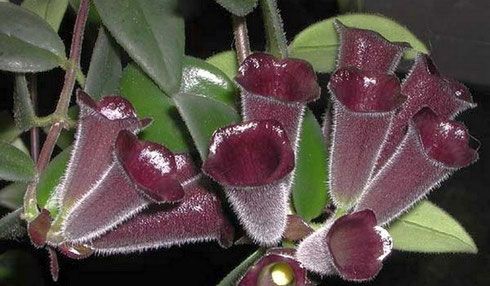

- Leaves turn yellow. Aeschinanthus leaves turn yellow when there is insufficient moisture, a deficit or, conversely, an overabundance of light.
- There is a massive drop of foliage. Leaves fall off for several reasons: at too low a temperature of the content, constant drafts, insufficient watering.
- Aeschinanthus darkened from roots to leaves. The main reason for the disease of the plant is that the owners overdid it with watering and airing. Such negative consequences can also occur with sudden changes in temperature, watering with cold or hard water. It is also a natural sign of aging.
Transfer
If you bought the plant from a flower shop, then you need to transplant it into new soil as soon as possible. The fact is that before being sold, eschinanthuses are placed in a peat mixture, which retains moisture better. This reduces the maintenance of crops, but such a substrate is not suitable for long-term cultivation. Therefore, it is important to transplant the flower as soon as you bring it home. For this event, you can use a universal soil, with the addition of perlite, expanded clay or vermiculite.
But it is better to make the substrate yourself from sphagnum, leafy earth, peat and sand, mixed in a ratio of 1: 2: 2: 1. Before transplanting, be sure to disinfect the soil, otherwise the plant can infect bacteria and pests that live in the soil. To do this, keep the mixture over steam or roast it in the oven. And don't forget to put a 1-inch layer of drainage on the bottom of the pot.
In the future, transplant the eschinanthus using the transshipment method every year. Host this activity after flowering. You should not plant a plant in a container that is too voluminous, because a tropical handsome man feels better in cramped pots. Therefore, during transplantation, use a container whose volume is 1–2 cm larger than the previous one. In addition, if the eschinanthus is not yet cramped in the old pot, then the transplant can be canceled, but the topsoil must be replaced.
Marble Aeschinanthus
Young Aeschinanthus usually blooms without any problems. But next season it may show character and not grow buds. It can be quite difficult to understand why the plant is capricious.
Eschinanthus marble (lat. Aeschynanthus marmoratus) In shape, Aeschynanthus resembles a distorted flower with very long shoots hanging down. The flowers are tubular in shape, slightly resemble the shape of a gramophone and have a variety of colors. They are located in the axils of the leaves or at the ends of the shoots in bunches. The plant is ampelous, so it will look good in a flowerpot or a hanging basket. It begins to bloom in July and continues until mid-autumn.Aeschinanthus marble is mainly grown for its beautiful leaves, and eschinanthus is rooted because of its unusual dark flowers. These plants grow in tropical rainforests on trees, like epiphytes.
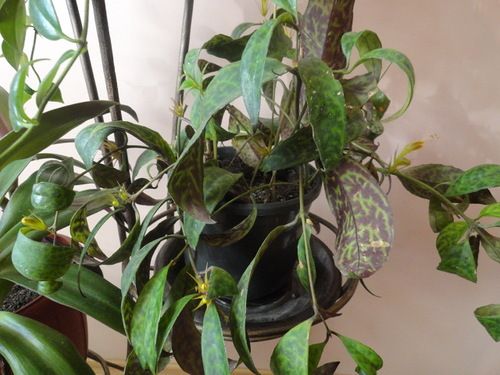

Care features
In winter, Aeschinanthus needs the brightest place, but in summer he loves partial shade. In order for the escinanthus to bloom regularly, give it a rest period of at least 4 weeks. The temperature regime of the winter content is 15 ° С, the summer temperature is 20-22 ° С.
To avoid dropping leaves, protect against sudden changes in temperature and improper watering. Loves abundant watering with warm water and moderately moist soil. Winter watering is moderate. High humidity and frequent spraying are preferred. From March to September, fertilizer is applied with watering every 2-3 weeks. Can be propagated by cuttings of the upper shoots for this, the temperature should be 24 ° C.
Description of the plant
Eschinanthus is a genus of plants of the Gesneriaceae family, which, according to various sources, consists of 80–170 different species. Under natural conditions, they all grow in Southeast Asia and are located on tropical trees as epiphytes. These plants settle on the branches and trunks of trees, but do not live off them, but use them as a support. An adult plant can grow from 30 to 90 cm. Aeschinanthus blooms all year round. Flowers can be apical or axillary, single or collected in inflorescences. Red-pink tones predominate, but orange and yellow specimens are found. At home, marble eschinanthus grows in hanging baskets or pots. As in nature, he loves the sun, moist and warm air.
Pests
Aeschinanthus is also annoyed by parasitic insects. Often, flower growers have to deal with such pests:
- Spider mite. The parasite can be recognized by the whitish cobweb covering the flower, as well as yellowish spots and dots on the leaves. To get rid of the pest, rinse the plant in the shower. But make sure that no water gets into the soil. To do this, wrap the pot in plastic. After water treatment, spray the plant with a systemic insecticide, such as Actellic.
- Shield. This pest looks like hard brown plaques localized on the stems and lower parts of the leaves. To get rid of parasites, remove the insects with a swab dipped in soapy water. Treat the flower itself with any insecticide. Repeat these activities at intervals of 2 weeks until the pests are completely destroyed.
- Mealybug. You can recognize the pest by the white fluffy lumps that appear on the leaves and shoots. It is not difficult to destroy parasites, it is enough to wipe the flower with a damp cloth, and then spray the culture with a weak solution of insecticide or alcohol.
Providing proper care for an Aeschinanthus at home is not easy. But if you make an effort and adhere to the recommendations for growing, then you will be able to "tame" this tropical beauty. And then your collection of domestic plants will be replenished with an unusual and original specimen.
Features of seasonal care
Plant care rules depending on the season:
| Season | Lighting | Humidity | Temperature |
| Spring | Bright, some varieties require partial shade | Not less than 60-70%, you can increase it by spraying the leaves, or put a container with wet sphagnum next to the flowerpot | + 18-20 degrees, avoid drafts during ventilation |
| Summer | Bright, diffused | + 20-25 degrees, it is allowed to transfer the plant to the balcony, it is not advisable to place it on the street | |
| Fall | |||
| Winter | Bright, supplemented with special lamps | If the room temperature is low, there is no need to increase the humidity, especially in winter. | + 16-18 degrees, do not allow it to decrease less than +15 degrees |
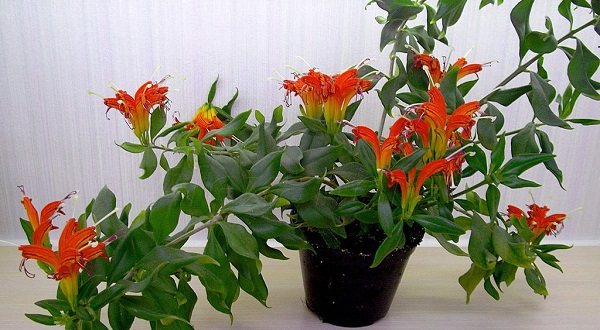

Pruning
This type of indoor plant needs periodic pruning.Otherwise, its branches will stretch out strongly and become bare, which will have a bad effect on the decorativeness of the tropical handsome man. Therefore, after flowering, you need to cut off all strongly stretched and damaged shoots. And also during the entire growing season, dried leaves and buds should be removed.
Alas, even if you properly care for the escinanthus and provide him with comfortable conditions, it will still lose its decorative effect in 5 years, because by that time its branches will be very stretched and bare. And even timely pruning will not protect the plant from this.
But it is not necessary to go to the store for a new pet, because several strong specimens can be grown from an adult Aeschinanthus, which will become a worthy replacement. Moreover, this is not so difficult to do.

